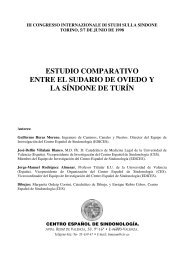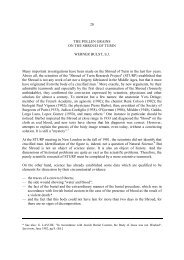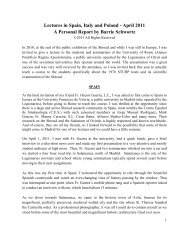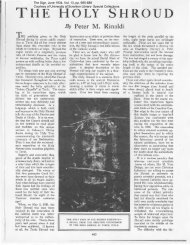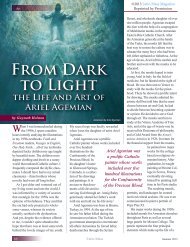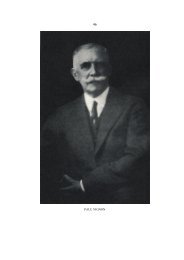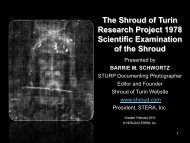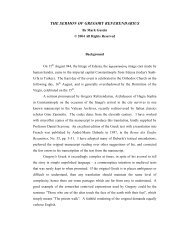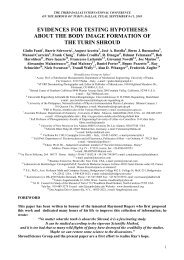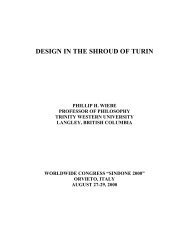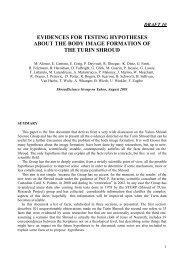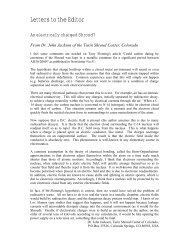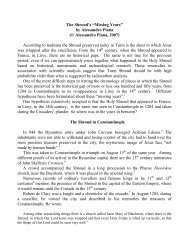Shroud - Summary of Challenges to the ... - Shroud of Turin
Shroud - Summary of Challenges to the ... - Shroud of Turin
Shroud - Summary of Challenges to the ... - Shroud of Turin
Create successful ePaper yourself
Turn your PDF publications into a flip-book with our unique Google optimized e-Paper software.
<strong>Summary</strong> <strong>of</strong> <strong>Challenges</strong> <strong>to</strong> <strong>the</strong> Au<strong>the</strong>nticity <strong>of</strong> <strong>the</strong> <strong>Shroud</strong> <strong>of</strong> <strong>Turin</strong><br />
By Richard B. Sorensen<br />
©2007 All Rights Reserved<br />
rich@westernesse.com<br />
A. Introduction<br />
The <strong>Shroud</strong> <strong>of</strong> <strong>Turin</strong> is purported <strong>to</strong> be <strong>the</strong> literal burial shroud <strong>of</strong> Jesus Christ, and its<br />
au<strong>the</strong>nticity has thus aroused intense debate and sometimes hostile rhe<strong>to</strong>ric between those<br />
who believe that <strong>the</strong> <strong>Shroud</strong> is au<strong>the</strong>ntic (or at least believe that it is <strong>the</strong> actual burial<br />
shroud <strong>of</strong> a crucified man who may or may not have been Jesus), and those who do not.<br />
Many attempts have been made by skeptics <strong>to</strong> challenge its au<strong>the</strong>nticity on various<br />
grounds, as well as <strong>to</strong> develop alternative <strong>the</strong>ories <strong>to</strong> explain how <strong>the</strong> images on <strong>the</strong><br />
<strong>Shroud</strong> could have been faked or generated by a variety <strong>of</strong> mechanisms. The <strong>Shroud</strong> <strong>of</strong><br />
<strong>Turin</strong> is <strong>the</strong>refore <strong>the</strong> most highly studied relic in <strong>the</strong> his<strong>to</strong>ry <strong>of</strong> <strong>the</strong> world.<br />
The his<strong>to</strong>ry <strong>of</strong> religious artifacts is filled with fraudulent attempts <strong>to</strong> make money at <strong>the</strong><br />
expense <strong>of</strong> naïve worshippers, and many fake shrouds have been produced. In 1902<br />
François de Mely claimed that <strong>the</strong>re were forty-two medieval shrouds <strong>of</strong> Christ around<br />
Europe, and he even named <strong>the</strong> <strong>to</strong>wns whose inven<strong>to</strong>ries mentioned <strong>the</strong>m (<strong>the</strong>se were<br />
ei<strong>the</strong>r simply pieces <strong>of</strong> cloth or artistic copies, and a number <strong>of</strong> <strong>the</strong>se “shrouds” still<br />
exist). 1 Even though many <strong>of</strong> <strong>the</strong>se fake shrouds were not done with <strong>the</strong> intent <strong>to</strong> deceive<br />
(i.e., <strong>the</strong>y were meant simply as artistic representations <strong>of</strong> Christ, and as an aid <strong>to</strong><br />
worship, ra<strong>the</strong>r than as a means <strong>of</strong> raising money), never<strong>the</strong>less, it is very appropriate that<br />
<strong>the</strong> <strong>Shroud</strong> <strong>of</strong> <strong>Turin</strong> be approached with an attitude <strong>of</strong> skepticism. However, <strong>the</strong> evidence<br />
for <strong>the</strong> <strong>Shroud</strong>’s au<strong>the</strong>nticity is so comprehensive and compelling that if it were an object<br />
with no religious over<strong>to</strong>nes, <strong>the</strong>re would be little serious doubt as <strong>to</strong> its veracity. But<br />
being <strong>the</strong> purported burial cloth <strong>of</strong> Jesus Christ and a possible witness <strong>to</strong> his resurrection,<br />
and hence <strong>to</strong> <strong>the</strong> alleged truth <strong>of</strong> Christianity, <strong>the</strong> <strong>Shroud</strong> raises powerful passions.<br />
Accepting or rejecting <strong>the</strong> au<strong>the</strong>nticity <strong>of</strong> <strong>the</strong> <strong>Shroud</strong> is <strong>to</strong> many thus an issue <strong>of</strong> religious<br />
or anti-religious conviction. However, those who seriously seek <strong>to</strong> study <strong>the</strong> <strong>Shroud</strong><br />
should approach it with an open mind and lay aside <strong>the</strong>ir religious persuasions as <strong>the</strong>y<br />
examine <strong>the</strong> evidence, both pro and con.<br />
Because challenges <strong>to</strong> <strong>the</strong> <strong>Shroud</strong> have been made and refuted in many forums, an<br />
interested reader must search in a number <strong>of</strong> places <strong>to</strong> find <strong>the</strong> desired information. The<br />
purpose <strong>of</strong> this paper is not <strong>to</strong> present any new <strong>the</strong>ories or evidence, but ra<strong>the</strong>r <strong>to</strong> ga<strong>the</strong>r<br />
all <strong>of</strong> <strong>the</strong> known challenges <strong>to</strong> <strong>the</strong> <strong>Shroud</strong>’s au<strong>the</strong>nticity along with answers <strong>to</strong> each<br />
challenge. These will be stated in summary form, and in (hopefully) clear English for a<br />
non-technical audience. References are also provided so that such a reader can easily<br />
investigate each issue in more detail. However, it should be noted that web pages may be<br />
taken down or relocated by <strong>the</strong> web masters <strong>of</strong> <strong>the</strong> associated sites, creating a dead link.<br />
That eventuality is beyond <strong>the</strong> control <strong>of</strong> any author.<br />
1 Daniel Scavone, Deconstructing <strong>the</strong> “Debunking <strong>of</strong> <strong>the</strong> <strong>Shroud</strong>”, www.shroud.com/bar.htm<br />
1
B. Nature <strong>of</strong> <strong>the</strong> <strong>Challenges</strong> <strong>to</strong> <strong>the</strong> <strong>Shroud</strong><br />
The first general type <strong>of</strong> challenge <strong>to</strong> <strong>the</strong> <strong>Shroud</strong> concerns its his<strong>to</strong>rical veracity—that is<br />
not a genuine his<strong>to</strong>rical relic dating from circa 33 AD. There is no way <strong>of</strong> definitively<br />
proving that <strong>the</strong> <strong>Shroud</strong> is au<strong>the</strong>ntic, as by its very nature a his<strong>to</strong>rical artifact cannot be<br />
proven true, especially one that is supposedly 2,000 years old. The best that one can do is<br />
<strong>to</strong> cite documentary evidence that argues for or against its existence at various points in<br />
<strong>the</strong> past.<br />
The second general type <strong>of</strong> challenge <strong>to</strong> <strong>the</strong> <strong>Shroud</strong> is in regard <strong>to</strong> issues <strong>of</strong> forgery and<br />
science—a his<strong>to</strong>rical artifact can be disproven or cast in<strong>to</strong> serious doubt by demonstrating<br />
that it ei<strong>the</strong>r was or could have been made in ano<strong>the</strong>r era. This approach assumes that <strong>the</strong><br />
<strong>Shroud</strong> was somehow produced by a medieval forger (<strong>the</strong> documented his<strong>to</strong>ry <strong>of</strong> <strong>the</strong><br />
<strong>Shroud</strong> goes back <strong>to</strong> <strong>the</strong> fourteenth century), and seeks <strong>to</strong> explain how a technology<br />
available <strong>to</strong> an artist at that time could have been used <strong>to</strong> produce a fake shroud.<br />
Both his<strong>to</strong>rical and scientific challenges are considered below.<br />
C. Characteristics <strong>of</strong> <strong>the</strong> <strong>Shroud</strong><br />
His<strong>to</strong>rical research, as well as <strong>the</strong> intensive scientific studies that have been done on <strong>the</strong><br />
<strong>Shroud</strong>, have shown that it has a number <strong>of</strong> properties that must be considered and<br />
answered by any skeptic who seeks <strong>to</strong> challenge <strong>the</strong> <strong>Shroud</strong>’s au<strong>the</strong>nticity. These<br />
characteristics are as follows:<br />
• First Recorded Showing. The first recorded showing <strong>of</strong> <strong>the</strong> <strong>Shroud</strong> was in <strong>the</strong><br />
period 1355-57, and it was publicly displayed many times after that, so if it were a<br />
painting or o<strong>the</strong>r type <strong>of</strong> forgery, it must have been done prior <strong>to</strong> or during that<br />
period, and with <strong>the</strong> technology available in that era. Leonardo DaVinci, who<br />
some have alleged <strong>to</strong> be <strong>the</strong> artist, was born in 1452.<br />
• Body Characteristics. The <strong>Shroud</strong> image is highly realistic and detailed, and<br />
depicts many bodily wounds that are completely consistent with Biblical accounts<br />
<strong>of</strong> <strong>the</strong> crucifixion, such as whipping, lacerations, contusions, scalp punctures,<br />
wound in <strong>the</strong> side, etc. Detailed examinations <strong>of</strong> <strong>the</strong> image by medical<br />
investiga<strong>to</strong>rs have uniformly confirmed its accuracy.<br />
• Lack <strong>of</strong> Clothing. The <strong>Shroud</strong> figure is naked, which would have been<br />
repugnant and unacceptable for a medieval artist in depicting Christ.<br />
• Nails through <strong>the</strong> Wrists ra<strong>the</strong>r than <strong>the</strong> Hands. The plethora <strong>of</strong> artistic<br />
depictions <strong>of</strong> Jesus from <strong>the</strong> first through <strong>the</strong> sixteenth centuries all show him as<br />
being nailed <strong>to</strong> <strong>the</strong> cross through <strong>the</strong> hands, whereas in <strong>the</strong> <strong>Shroud</strong> image he is<br />
nailed through <strong>the</strong> wrists (<strong>the</strong> <strong>Shroud</strong> only shows <strong>the</strong> exit wounds and does not<br />
depict at what point <strong>the</strong> nails entered). As indicated below, nailing through <strong>the</strong><br />
hands would not have supported a man’s weight, and <strong>the</strong> purported artist would<br />
have had <strong>to</strong> have both knowledge <strong>of</strong> that fact, and gone against all artistic<br />
2
precedent.<br />
• Image Characteristics. The <strong>Shroud</strong> is linen, and raw unprepared linen repels<br />
water and is a difficult medium <strong>to</strong> work on. Fur<strong>the</strong>rmore, <strong>the</strong>re are no pigments<br />
or brushstrokes. The image is without substance, and is made up <strong>of</strong> “lines” <strong>of</strong><br />
darker coloration imprinted in<strong>to</strong> <strong>the</strong> surface fibers <strong>of</strong> <strong>the</strong> cloth. These lines are<br />
approximately 1/100 <strong>the</strong> width <strong>of</strong> a human hair, making it impossible for <strong>the</strong><br />
image <strong>to</strong> have been painted or manually created by an artist. Also, <strong>the</strong> depth <strong>of</strong><br />
<strong>the</strong> actual <strong>Shroud</strong> image is very thin. 2<br />
• Foreshortening. Because <strong>the</strong> man’s head and knees are slightly bent, <strong>the</strong> image<br />
has foreshortening in it. The concept <strong>of</strong> foreshortening was first discovered and<br />
used by <strong>the</strong> Renaissance painters some time after <strong>the</strong> <strong>Shroud</strong> was first shown. 3<br />
• Pho<strong>to</strong>graphic Nature. The image is “pho<strong>to</strong>graphic” in nature ra<strong>the</strong>r than<br />
“artistic,” and <strong>the</strong>re is no artistic “style.” 4 However, it lacks <strong>the</strong> sharp edging and<br />
outline <strong>of</strong> a pho<strong>to</strong>graph or a painting, and also lacks color differentiation—<strong>the</strong><br />
entire image is a fairly-uniform sepia-yellow <strong>to</strong>ne.<br />
• Negative Image. The picture on <strong>the</strong> <strong>Shroud</strong> is actually a negative image, and<br />
must be pho<strong>to</strong>graphically inverted <strong>to</strong> see <strong>the</strong> positive image. Concepts <strong>of</strong><br />
negative images were certainly known in <strong>the</strong> past; for example, <strong>the</strong> mold that is<br />
used <strong>to</strong> cast a statue is a “negative image.” But no true negative images were seen<br />
until <strong>the</strong> invention <strong>of</strong> pho<strong>to</strong>graphy around 1826. In fact, this aspect <strong>of</strong> <strong>the</strong> <strong>Shroud</strong><br />
was not noticed until <strong>the</strong> <strong>Shroud</strong> was first pho<strong>to</strong>graphed in 1898. 5<br />
• 3D Image. The image has three-dimensional qualities, as <strong>the</strong> darkness <strong>of</strong> <strong>the</strong><br />
image is proportionate <strong>to</strong> <strong>the</strong> distance between <strong>the</strong> cloth and <strong>the</strong> associated body<br />
part. For example, <strong>the</strong> nose area is shown very strongly, but <strong>the</strong> eyes less so.<br />
Three-dimensional “maps” have been created using several image analyzing<br />
systems that show <strong>the</strong> face and o<strong>the</strong>r parts <strong>of</strong> <strong>the</strong> body <strong>of</strong> <strong>the</strong> <strong>Shroud</strong> man in basrelief.<br />
6<br />
• Blood. A number <strong>of</strong> researchers have demonstrated <strong>the</strong> presence <strong>of</strong> blood on <strong>the</strong><br />
<strong>Shroud</strong> in various places, and some have done DNA testing, but <strong>the</strong> blood has<br />
proved <strong>to</strong> be <strong>to</strong>o old and degraded <strong>to</strong> obtain any useful DNA test results. 7 It has<br />
also been shown that <strong>the</strong>re is no image in <strong>the</strong> areas where <strong>the</strong> blood exists; <strong>the</strong><br />
2 Alan D. Adler, The Nature <strong>of</strong> <strong>the</strong> Body Images on <strong>the</strong> <strong>Shroud</strong> <strong>of</strong> <strong>Turin</strong>,<br />
www.shroud.com/pdfs/adler.pdf<br />
3 Isabel Piczek, Is <strong>the</strong> <strong>Shroud</strong> <strong>of</strong> <strong>Turin</strong> a Painting?, www.shroud.com/piczek.htm<br />
4 Isabel Piczek, The Concept <strong>of</strong> Negativity Through <strong>the</strong> Ages vs The Negative Image on <strong>the</strong> <strong>Shroud</strong>,<br />
www.shroud.com/piczek3.htm<br />
5 Isabel Piczek, The Concept <strong>of</strong> Negativity Through <strong>the</strong> Ages vs The Negative Image on <strong>the</strong> <strong>Shroud</strong>,<br />
www.shroud.com/piczek3.htm<br />
6 Peter M. Schumacher, Pho<strong>to</strong>grammetric Responses from <strong>the</strong> <strong>Shroud</strong> <strong>of</strong> <strong>Turin</strong>,<br />
www.shroud.com/pdfs/schumchr.pdf<br />
7 Raymond Rogers, Frequently Asked Questions, www.shroud.com/pdfs/rogers5faqs.pdf<br />
3
lood was apparently deposited on <strong>the</strong> <strong>Shroud</strong> first, and acted <strong>to</strong> inhibit <strong>the</strong> image<br />
formation mechanism.<br />
• Secondary Image. It was recently discovered that <strong>the</strong>re is ano<strong>the</strong>r faint facial<br />
image on <strong>the</strong> back side <strong>of</strong> <strong>the</strong> cloth matching <strong>the</strong> main facial image, making it<br />
very hard for <strong>the</strong> <strong>Shroud</strong> <strong>to</strong> be a fake. 8 This was not detected previously because<br />
<strong>of</strong> <strong>the</strong> backing material that had been sewn on <strong>to</strong> <strong>the</strong> <strong>Shroud</strong>.<br />
The above known characteristics create a high standard for all would-be <strong>Shroud</strong><br />
debunkers. In <strong>the</strong> words <strong>of</strong> <strong>the</strong> <strong>Shroud</strong> researcher John Walsh,<br />
The <strong>Shroud</strong> <strong>of</strong> <strong>Turin</strong> is ei<strong>the</strong>r <strong>the</strong> most awesome and instructive relic <strong>of</strong> Jesus<br />
Christ in existence... or it is one <strong>of</strong> <strong>the</strong> most ingenious, most unbelievably clever<br />
products <strong>of</strong> <strong>the</strong> human mind and hand on record. It is one or <strong>the</strong> o<strong>the</strong>r; <strong>the</strong>re is<br />
no middle ground. 9<br />
Donald Lynn, a member <strong>of</strong> <strong>the</strong> STURP team in considering <strong>the</strong> incredibly<br />
difficult task <strong>of</strong> artistically creating <strong>the</strong> <strong>Shroud</strong> image, concluded, “It would be<br />
miraculous if it were a forgery.”<br />
D. <strong>Challenges</strong> <strong>to</strong> <strong>the</strong> <strong>Shroud</strong>’s Au<strong>the</strong>nticity<br />
Following are <strong>the</strong> significant challenges that have been made <strong>to</strong> <strong>the</strong> <strong>Shroud</strong> <strong>of</strong> <strong>Turin</strong>’s<br />
au<strong>the</strong>nticity.<br />
1. The <strong>Shroud</strong> was missing for much <strong>of</strong> its purported his<strong>to</strong>ry<br />
There are gaps in <strong>the</strong> his<strong>to</strong>rical record for various periods, and <strong>the</strong> early evidence<br />
is especially weak. That fact, in itself, does not disprove <strong>the</strong> <strong>Shroud</strong>, but does<br />
raise questions about its au<strong>the</strong>nticity. Following is <strong>the</strong> his<strong>to</strong>rical and documentary<br />
evidence for <strong>the</strong> existence <strong>of</strong> <strong>the</strong> <strong>Shroud</strong> that has been discovered by scholars.<br />
The his<strong>to</strong>ry is divided in<strong>to</strong> periods, each <strong>of</strong> which represents a movement <strong>of</strong> <strong>the</strong><br />
<strong>Shroud</strong> from one location or holder <strong>to</strong> ano<strong>the</strong>r.<br />
a. The period from c. 33 <strong>to</strong> 544—<strong>Shroud</strong> location not known, possibly Edessa,<br />
Antioch, and/or Jerusalem.<br />
There is a complete lack <strong>of</strong> any known documentary evidence for <strong>the</strong><br />
<strong>Shroud</strong>’s existence in Biblical times. The first known record <strong>of</strong> its possible<br />
existence was in <strong>the</strong> fourth century. 10 However, it must be remembered that<br />
Christians were persecuted and repressed during this time, first by <strong>the</strong> Jewish<br />
authorities and later by <strong>the</strong> Romans. Persecution began immediately (c. 33<br />
AD) and continued in fits and starts until <strong>the</strong> Emperor Constantine’s Edict <strong>of</strong><br />
8<br />
Giulio Fanti and Rober<strong>to</strong> Maggiolo, A New <strong>Shroud</strong> Image Discovered in 2004,<br />
www.skepticalspectacle.com/images11.htm<br />
9<br />
William Meacham, The Au<strong>the</strong>ntication <strong>of</strong> <strong>the</strong> <strong>Turin</strong> <strong>Shroud</strong>: An Issue in Archaeological Epistemology,<br />
www.shroud.com/meacham2.htm<br />
10<br />
Jack Markwardt, The Fire and <strong>the</strong> Portrait, www.shroud.com/markwar2.htm<br />
4
Milan in 313. Christians <strong>of</strong>ten met in secret and did not generally have public<br />
places <strong>of</strong> worship during <strong>the</strong> first three centuries. Therefore, any important<br />
relics would have been kept hidden.<br />
There is a fourth-century Syrian s<strong>to</strong>ry from Edessa about a religious<br />
object known as <strong>the</strong> “Mandylion cloth” which reappears at various times. 11<br />
King Abgar, a ruler <strong>of</strong> Edessa from 177 <strong>to</strong> 212, was reputed have become a<br />
Christian. He made a request <strong>to</strong> <strong>the</strong> Pope <strong>to</strong> send religious emissaries <strong>to</strong><br />
Edessa, which was recorded in <strong>the</strong> Liber Pontificalis, <strong>the</strong> records <strong>of</strong> papal<br />
actions. There is a later iconic picture <strong>of</strong> King Abgar holding <strong>the</strong> <strong>Shroud</strong> with<br />
<strong>the</strong> face <strong>of</strong> Christ displayed. 12<br />
b. The period from 544 <strong>to</strong> 944—<strong>Shroud</strong> is in Edessa.<br />
In 544 a religious object known as <strong>the</strong> “Mandylion cloth” was presented <strong>to</strong> <strong>the</strong><br />
ruler <strong>of</strong> Edessa and kept in <strong>the</strong> city for four hundred years. It was said <strong>to</strong> be a<br />
“holy palladium” with protective properties and it supposedly protected <strong>the</strong><br />
city <strong>of</strong> Edessa from attack by <strong>the</strong> Persians. 13 According <strong>to</strong> some s<strong>to</strong>ries, <strong>the</strong><br />
<strong>Shroud</strong> was hidden inside one <strong>of</strong> <strong>the</strong> city walls <strong>of</strong> Edessa, perhaps for most <strong>of</strong><br />
<strong>the</strong> time <strong>of</strong> its existence <strong>the</strong>re, and possibly forgotten.<br />
There are several references <strong>to</strong> <strong>the</strong> <strong>Shroud</strong> during this period; in 730,<br />
St. John Damascene, in his anti-iconoclastic <strong>the</strong>sis, On Holy Images, describes<br />
<strong>the</strong> cloth as a himation, which is translated as an oblong cloth or grave cloth. 14<br />
Pope Stephen II (752—757) described <strong>the</strong> <strong>Shroud</strong> as follows: “Christ spread<br />
out his entire body on a linen cloth that was white as snow. On this cloth,<br />
marvelous as it is <strong>to</strong> see… <strong>the</strong> glorious image <strong>of</strong> <strong>the</strong> Lord's face, and <strong>the</strong><br />
length <strong>of</strong> his entire and most noble body, has been divinely transferred.” 15<br />
c. The period from 944 <strong>to</strong> 1204—<strong>Shroud</strong> is in Constantinople.<br />
The <strong>Shroud</strong> was thought <strong>to</strong> have been kept in Edessa until 944 when<br />
Byzantine troops besieged <strong>the</strong> city. The general <strong>of</strong> <strong>the</strong> Byzantine forces<br />
<strong>of</strong>fered <strong>the</strong> city's Moslem Emir a huge sum <strong>of</strong> money, <strong>the</strong> freeing <strong>of</strong> 200<br />
Moslem captives, and <strong>the</strong> promise <strong>of</strong> perpetual immunity, all for just one<br />
thing—<strong>the</strong> “Mandylion cloth.” 16 It was <strong>the</strong>n brought <strong>to</strong> Constantinople on 15<br />
August 944 for <strong>the</strong> purpose <strong>of</strong> “obtaining a new and powerful force <strong>of</strong> divine<br />
protection.” 17 The <strong>Shroud</strong>’s arrival was celebrated with processions and it<br />
was placed in <strong>the</strong> Pharos Chapel, <strong>the</strong> imperial treasury for relics located in <strong>the</strong><br />
palace <strong>of</strong> <strong>the</strong> emperor. There are several surviving eyewitness accounts <strong>of</strong><br />
that day—<strong>the</strong> Narratio de Imagine Edessena, <strong>the</strong> Teaching <strong>of</strong> Addai, and <strong>the</strong><br />
Acts <strong>of</strong> Thaddeus, which—among o<strong>the</strong>r subjects—re<strong>to</strong>ld <strong>the</strong> s<strong>to</strong>ry <strong>of</strong> King<br />
11 Jack Markwardt, Antioch and <strong>the</strong> <strong>Shroud</strong>, www.shroud.com/pdfs/markward.pdf<br />
12 Barrie M. Schwortz, The <strong>Shroud</strong> <strong>of</strong> <strong>Turin</strong>, www.shroud.it/events.htm<br />
13 Jack Markwardt, The Cathar Crucifix: New Evidence <strong>of</strong> <strong>the</strong> <strong>Shroud</strong>'s Missing<br />
His<strong>to</strong>ry, www.shroud.com/pdfs/markwar3.pdf<br />
14 Mozarabic Rite, a Clue <strong>to</strong> <strong>the</strong> <strong>Shroud</strong> <strong>of</strong> <strong>Turin</strong>?, www.shrouds<strong>to</strong>ry.com/faq-mozarabic.htm<br />
15 Mozarabic Rite, a Clue <strong>to</strong> <strong>the</strong> <strong>Shroud</strong> <strong>of</strong> <strong>Turin</strong>?, www.shrouds<strong>to</strong>ry.com/faq-mozarabic.htm.<br />
16 John Ritchie, The Templars, The <strong>Shroud</strong>, The Veil and <strong>the</strong> Mandylion,<br />
www.templarhis<strong>to</strong>ry.com/mandylion.html<br />
17 Jack Markwardt, Antioch and <strong>the</strong> <strong>Shroud</strong>, www.shroud.com/pdfs/markward.pdf<br />
5
Abgar and related that <strong>the</strong> facial image on <strong>the</strong> <strong>Shroud</strong> was extremely faint,<br />
like a “moist secretion without pigments or <strong>the</strong> painter’s art.” 18 Gregory<br />
Referendarius, archdeacon <strong>of</strong> Hagia Sophia in Constantinople, was apparently<br />
a member <strong>of</strong> <strong>the</strong> clerical committee that arranged for <strong>the</strong> reception <strong>of</strong> <strong>the</strong><br />
<strong>Shroud</strong>. In a sermon dated 16 August 944, he mentioned that it was a fulllength<br />
image <strong>of</strong> Christ and carried his bloodstains. 19 Nicholas Mesarites, <strong>the</strong><br />
overseer <strong>of</strong> <strong>the</strong> imperial relic treasury in Constantinople, described <strong>the</strong> <strong>Shroud</strong><br />
in 1201, indicating that “in this place <strong>the</strong> naked Lord rises again, and <strong>the</strong><br />
burial sindons can prove it.” Mesarites’ description is particularly vivid and<br />
true-<strong>to</strong>-life because <strong>of</strong> his indication <strong>of</strong> <strong>the</strong> nudity <strong>of</strong> <strong>the</strong> <strong>Shroud</strong> figure, which<br />
was never done in artistic renderings <strong>of</strong> Christ. Thereafter <strong>the</strong> <strong>Shroud</strong> was<br />
regularly shown in Constantinople, although it was typically folded and kept<br />
in a reliquary so that only <strong>the</strong> face was visible.<br />
In 1147, Louis VII, King <strong>of</strong> France, visited <strong>the</strong> city and venerated <strong>the</strong><br />
<strong>Shroud</strong>, and it first appears in <strong>the</strong> lists <strong>of</strong> relics held at Constantinople in 1093<br />
as “<strong>the</strong> linens found in <strong>the</strong> <strong>to</strong>mb after <strong>the</strong> resurrection.” The <strong>Shroud</strong> was also<br />
seen and reported on by various crusaders when <strong>the</strong>y visited during <strong>the</strong><br />
crusader period <strong>of</strong> 1098 <strong>to</strong> 1204.<br />
d. The period from 1204 <strong>to</strong> 1355—<strong>Shroud</strong> is probably in Greece, <strong>the</strong>n France.<br />
The fourth crusade brought knights from Europe <strong>to</strong> Constantinople in 1204,<br />
and <strong>the</strong>re were several written testimonies <strong>of</strong> crusaders who saw <strong>the</strong> <strong>Shroud</strong> in<br />
Constantinople. These included <strong>the</strong> knight Robert de Clari who noted <strong>the</strong><br />
following:<br />
There was a Church which was called <strong>of</strong> My Lady Saint Mary <strong>of</strong><br />
Blachernae, where <strong>the</strong>re was <strong>the</strong> shroud in which Our Lord had been<br />
wrapped, which every Friday, raised itself upright so that one could<br />
see <strong>the</strong> form <strong>of</strong> Our Lord on it, and no one ei<strong>the</strong>r Greek or French,<br />
ever knew what became <strong>of</strong> this shroud when <strong>the</strong> city was taken. 20<br />
The city <strong>of</strong> Constantinople was sacked by <strong>the</strong> crusaders on 12 April 1204, and<br />
according <strong>to</strong> tradition <strong>the</strong> <strong>Shroud</strong> was <strong>the</strong>n brought <strong>to</strong> Greece or possibly<br />
France, but <strong>the</strong> date and <strong>the</strong> circumstances <strong>of</strong> <strong>the</strong> seizure are unknown. There<br />
is an inven<strong>to</strong>ry <strong>of</strong> <strong>the</strong> items in <strong>the</strong> Constantinople treasury, supposedly from<br />
1207, which lists <strong>the</strong> <strong>Shroud</strong> <strong>the</strong> Christ and indicates that it still “smelled <strong>of</strong><br />
myrrh.” However, in 1205 Theodore Ducas Anglelos wrote in a letter <strong>to</strong> Pope<br />
Innocent III:<br />
The Venetians partitioned <strong>the</strong> treasure <strong>of</strong> gold, silver and ivory,<br />
while <strong>the</strong> French did <strong>the</strong> same with <strong>the</strong> relics <strong>of</strong> saints and <strong>the</strong> most<br />
18<br />
Daniel Scavone, Joseph <strong>of</strong> Arima<strong>the</strong>a, The Holy Grail, and <strong>the</strong> Edessa Icon,<br />
www.shroud.it/scavone1.pdf<br />
19<br />
www.religionfacts.com/christianity/things/shroud_<strong>of</strong>_turin.htm<br />
20<br />
www.religionfacts.com/christianity/things/shroud_<strong>of</strong>_turin.htm<br />
6
sacred <strong>of</strong> all, <strong>the</strong> linen in which our Lord Jesus Christ was wrapped<br />
after His death and before <strong>the</strong> resurrection. 21<br />
Around <strong>the</strong> year 1211, <strong>the</strong> English lawyer and chronicler Gervase <strong>of</strong> Tilbury<br />
wrote his monumental Otia Imperialia and remarked in one passage:<br />
The s<strong>to</strong>ry is passed down from archives <strong>of</strong> ancient authority that <strong>the</strong><br />
Lord prostrated himself with his entire body on whitest linen, and so<br />
by divine power <strong>the</strong>re was impressed on <strong>the</strong> linen a most beautiful<br />
imprint <strong>of</strong> not only <strong>the</strong> face, but <strong>the</strong> entire body <strong>of</strong> <strong>the</strong> Lord.<br />
It is uncertain what became <strong>of</strong> <strong>the</strong> <strong>Shroud</strong> in <strong>the</strong> aftermath <strong>of</strong> <strong>the</strong> destruction<br />
<strong>of</strong> Constantinople during <strong>the</strong> fourth crusade. However, <strong>the</strong> explanation with<br />
<strong>the</strong> most documentary evidence, was that <strong>the</strong> <strong>Shroud</strong> was given <strong>to</strong> Othon de la<br />
Roche, a knight from <strong>the</strong> Burgundy region <strong>of</strong> France. He commanded <strong>the</strong><br />
district <strong>of</strong> Blachernae where <strong>the</strong> <strong>Shroud</strong> had been kept, and after <strong>the</strong> sack <strong>of</strong><br />
Constantinople by <strong>the</strong> crusaders, he is said <strong>to</strong> have been given <strong>the</strong> <strong>Shroud</strong> as<br />
well as <strong>the</strong> duchy <strong>of</strong> A<strong>the</strong>ns in Greece for his leading role in <strong>the</strong> crusade.<br />
Othon <strong>the</strong>n became <strong>the</strong> Duke <strong>of</strong> A<strong>the</strong>ns and Sparta and supposedly <strong>to</strong>ok <strong>the</strong><br />
cloth with him <strong>to</strong> Greece. The <strong>Shroud</strong> was seen <strong>the</strong>re according <strong>to</strong> two<br />
eyewitness accounts, by a letter <strong>of</strong> Theodore <strong>of</strong> Epirus dated 1 August 1205,<br />
and indirectly by Nicholas <strong>of</strong> Otran<strong>to</strong>, abbot <strong>of</strong> <strong>the</strong> monastery <strong>of</strong> Casole in<br />
1208.<br />
In 1219 an agent <strong>of</strong> <strong>the</strong> Byzantine emperor and ally <strong>of</strong> Othon went on<br />
a mission <strong>to</strong> Burgundy with a safe conduct pass and an armed guard, and it is<br />
possible that he carried <strong>the</strong> <strong>Shroud</strong> with him and gave it <strong>to</strong> Ponce de la Roche,<br />
Othon’s fa<strong>the</strong>r. Alternatively, it could have been brought <strong>to</strong> France by Othon<br />
himself when he returned <strong>to</strong> Burgundy in 1224. The <strong>Shroud</strong> was <strong>the</strong>n likely<br />
given <strong>to</strong> <strong>the</strong> Archbishop <strong>of</strong> Besançon and placed in <strong>the</strong> Ca<strong>the</strong>dral <strong>of</strong> St.<br />
Etienne in Besançon, where it is said <strong>to</strong> have been displayed each year on<br />
Easter until 1349. There are no records <strong>of</strong> it being displayed, but in 1349 a<br />
fire destroyed <strong>the</strong> ca<strong>the</strong>dral and all <strong>of</strong> its records, but <strong>the</strong> <strong>Shroud</strong> was removed<br />
and saved from <strong>the</strong> flames. At some point a painting was made <strong>of</strong> <strong>the</strong> frontal<br />
image <strong>of</strong> <strong>the</strong> <strong>Shroud</strong> and this painting was shown in <strong>the</strong> Besançon Ca<strong>the</strong>dral<br />
starting in 1356. But <strong>the</strong> real cloth was said <strong>to</strong> have been removed and given<br />
<strong>to</strong> Jeanne de Vergy, <strong>the</strong> great-great-granddaughter <strong>of</strong> Othon de la Roche and<br />
<strong>the</strong>refore probably <strong>the</strong> legal owner <strong>of</strong> <strong>the</strong> <strong>Shroud</strong>.<br />
Jeanne de Vergy married <strong>the</strong> French knight Ge<strong>of</strong>frey de Charny<br />
sometime in 1352-1353, and she supposedly gave him <strong>the</strong> cloth as a type <strong>of</strong><br />
dowry or wedding gift. De Charny has been attested through much<br />
documentation as <strong>the</strong> first definitely known owner <strong>of</strong> <strong>the</strong> <strong>Shroud</strong>, and he <strong>the</strong>n<br />
made it available for public display beginning around 1355. There are also<br />
o<strong>the</strong>r possible explanations for <strong>the</strong> <strong>Shroud</strong>’s whereabouts during <strong>the</strong> period <strong>of</strong><br />
21 The Mozarabic Rite, a Clue <strong>to</strong> <strong>the</strong> <strong>Shroud</strong> <strong>of</strong> <strong>Turin</strong>?, www.shrouds<strong>to</strong>ry.com/faq-mozarabic.htm<br />
7
1204-1355, but with less documentary support. 22<br />
e. The period from 1355 <strong>to</strong> 1464—<strong>Shroud</strong> is in France and Italy.<br />
His<strong>to</strong>rical evidence suggests that Ge<strong>of</strong>frey de Charny acquired <strong>the</strong> <strong>Shroud</strong> at<br />
some point between April 1349 and January 1354, and that ei<strong>the</strong>r he or his<br />
wife arranged for it <strong>to</strong> be shown for <strong>the</strong> first time in Europe, beginning around<br />
1355.<br />
De Charny was a man <strong>of</strong> honor and great influence in France—a<br />
counselor <strong>to</strong> King Phillip VI and his son, King John II <strong>the</strong> Good. De Charny<br />
was captured by <strong>the</strong> English after <strong>the</strong> Battle <strong>of</strong> Calais in 1349 and ransomed<br />
by King John II in 1351. Upon returning <strong>to</strong> France and marrying Jeanne de<br />
Vergy, he built a church in his home <strong>to</strong>wn <strong>of</strong> Lirey, a small <strong>to</strong>wn near Troyes<br />
in France, and named it <strong>the</strong> Annunciation <strong>of</strong> St. Mary, in praise <strong>to</strong> God for his<br />
rescue from <strong>the</strong> English. The first display <strong>of</strong> <strong>the</strong> <strong>Shroud</strong> in Europe was in this<br />
church. De Charny was given <strong>the</strong> highest honor <strong>of</strong> carrying <strong>the</strong> Oriflamme,<br />
<strong>the</strong> banner <strong>of</strong> <strong>the</strong> king, in<strong>to</strong> battle. He died at <strong>the</strong> Battle <strong>of</strong> Poitiers in 1356,<br />
shielding King John II from <strong>the</strong> attack <strong>of</strong> <strong>the</strong> English, and his widow<br />
continued <strong>the</strong> <strong>Shroud</strong> displays at Lirey for an unknown period. As in <strong>the</strong> case<br />
<strong>of</strong> o<strong>the</strong>r relics, a fee was charged <strong>to</strong> view <strong>the</strong> <strong>Shroud</strong>, possibly because Jeanne<br />
was in financial straits after <strong>the</strong> death <strong>of</strong> her husband. Many pilgrims came <strong>to</strong><br />
see it, but <strong>the</strong> displays eventually were s<strong>to</strong>pped for reasons unknown.<br />
Jeanne de Vergy remarried in 1389, and her new husband, Aymon <strong>of</strong><br />
Geneva, was <strong>the</strong> uncle <strong>of</strong> <strong>the</strong> Avignon Pope Clement VII. At this point<br />
Jeanne and her son Ge<strong>of</strong>frey II decided <strong>to</strong> exhibit <strong>the</strong> <strong>Shroud</strong> again.<br />
Displaying a relic required ecclesiastic approval which would normally have<br />
been sought through <strong>the</strong> local bishop, who at <strong>the</strong> time was Pierre d’Arcis, <strong>the</strong><br />
Bishop <strong>of</strong> Troyes. But due <strong>to</strong> her husband’s influence with <strong>the</strong> Pope, Jeanne<br />
and her son circumvented D’Arcis and appealed directly <strong>to</strong> <strong>the</strong> papal legate,<br />
Cardinal Pierre de Thury. Papal endorsement was duly given, and <strong>the</strong> <strong>Shroud</strong><br />
was again put on display. Special souvenir medallions were struck <strong>to</strong><br />
commemorate this <strong>Shroud</strong> exhibition (a surviving specimen can be seen at <strong>the</strong><br />
Cluny Museum in Paris), and it is at this point that <strong>the</strong> documented his<strong>to</strong>ry <strong>of</strong><br />
<strong>the</strong> <strong>Shroud</strong> begins, ironically with a complaint about its au<strong>the</strong>nticity.<br />
Bishop D’Arcis <strong>of</strong> Troyes strenuously objected <strong>to</strong> this exhibition and<br />
after writing <strong>to</strong> King Charles II and getting nowhere, he wrote <strong>the</strong> nowfamous<br />
D'Arcis Memorandum <strong>to</strong> Pope Clement VII. In his memorandum<br />
Bishop D’Arcis referred <strong>to</strong> <strong>the</strong> Archbishop Henri de Poitiers, who had<br />
supposedly come <strong>to</strong> <strong>the</strong> conclusion that <strong>the</strong> <strong>Shroud</strong> was a forgery some<br />
“thirty-four years or <strong>the</strong>reabouts” previously (i.e., in 1355) and had<br />
supposedly conducted an inquest in<strong>to</strong> <strong>the</strong> <strong>Shroud</strong> at that time. This memo is<br />
<strong>of</strong>ten used <strong>to</strong> “prove” that <strong>the</strong> <strong>Shroud</strong> was not genuine—it indicates that an<br />
artist had confessed <strong>to</strong> painting <strong>the</strong> <strong>Shroud</strong>. But <strong>the</strong> artist was never<br />
identified, no confession has ever been found, and it is not clear that D’Arcis<br />
ever examined <strong>the</strong> <strong>Shroud</strong> himself. Fur<strong>the</strong>rmore, D’Arcis’ motives have been<br />
questioned for several reasons: in addition <strong>to</strong> his pique about not being<br />
22 Richard B. Sorensen, The True Holy Grail, www.unholygrailbook.com/docs/<strong>the</strong>_true_holy_grail.pdf<br />
8
consulted, D’Arcis apparently wanted <strong>the</strong> revenues from <strong>the</strong> <strong>Shroud</strong> flowing<br />
<strong>to</strong> him in Troyes. The ro<strong>of</strong> <strong>of</strong> <strong>the</strong> Troyes Ca<strong>the</strong>dral collapsed around <strong>the</strong> same<br />
time that he wrote his Memorandum, and many <strong>of</strong> <strong>the</strong> relics were damaged or<br />
destroyed; D’Arcis needed cash for repairs and <strong>to</strong> compensate for <strong>the</strong> loss <strong>of</strong><br />
his relics revenue. Also, <strong>the</strong> only known correspondence from Henri de<br />
Poitiers <strong>to</strong> Ge<strong>of</strong>frey de Charny, which is dated 1356, praises De Charny for<br />
his piety and chivalry, and for helping <strong>to</strong> develop <strong>the</strong> “divine cult.” It is<br />
unclear what Poitiers means by this, but it may have been a reference <strong>to</strong> <strong>the</strong><br />
<strong>Shroud</strong> displays.<br />
In any case, a series <strong>of</strong> correspondences ensued between Clement VII,<br />
<strong>the</strong> churchmen <strong>of</strong> Lirey, and <strong>the</strong> De Charnys. The final result was a papal<br />
order <strong>to</strong> D’Arcis requiring him <strong>to</strong> be silent and refrain from any fur<strong>the</strong>r attacks<br />
under pain <strong>of</strong> excommunication, and ano<strong>the</strong>r <strong>to</strong> <strong>the</strong> De Charnys and <strong>the</strong> Lirey<br />
church allowing <strong>the</strong>m <strong>to</strong> display <strong>the</strong> <strong>Shroud</strong> but with <strong>the</strong> stipulation that it<br />
could not be claimed as <strong>the</strong> true <strong>Shroud</strong> <strong>of</strong> Christ. The next year Clement<br />
reversed himself and issued a papal order granting new indulgences <strong>to</strong> those<br />
who visited <strong>the</strong> Lirey church and its relics, indicating that he <strong>the</strong>n probably<br />
believed <strong>the</strong> cloth <strong>to</strong> be genuine. During this period <strong>the</strong> <strong>Shroud</strong> remained with<br />
<strong>the</strong> De Charny family. 23<br />
f. The period from 1464 <strong>to</strong> present—<strong>Shroud</strong> is in Italy.<br />
After <strong>the</strong> death <strong>of</strong> Ge<strong>of</strong>frey II, <strong>the</strong> <strong>Shroud</strong> came in<strong>to</strong> <strong>the</strong> possession <strong>of</strong><br />
Margaret de Charny, his daughter, who allowed it <strong>to</strong> be publicly viewed on a<br />
number <strong>of</strong> occasions during <strong>the</strong> period <strong>of</strong> 1400-53. In 1453-54 she sold <strong>the</strong><br />
<strong>Shroud</strong> <strong>to</strong> <strong>the</strong> Duke Louis I <strong>of</strong> Savoy and received <strong>the</strong> castle <strong>of</strong> Varambon and<br />
revenues <strong>of</strong> <strong>the</strong> estate <strong>of</strong> Miribel near Lyon for “valuable services” from him.<br />
Meanwhile <strong>the</strong> Lirey churchmen, missing <strong>the</strong> income that had been generated<br />
by <strong>the</strong> <strong>Shroud</strong>, were attempting <strong>to</strong> get it returned <strong>to</strong> <strong>the</strong>m. In 1464 Duke<br />
Louis I <strong>of</strong> Savoy agreed <strong>to</strong> pay <strong>the</strong>m an annual rent, <strong>to</strong> be drawn from <strong>the</strong><br />
revenues <strong>of</strong> <strong>the</strong> castle <strong>of</strong> Gaillard, near Geneva, as compensation for <strong>the</strong>ir loss<br />
<strong>of</strong> <strong>Shroud</strong> revenues. This agreement was drawn up in Paris and is <strong>the</strong> first<br />
known document indicating that <strong>the</strong> <strong>Shroud</strong> had become <strong>the</strong> property <strong>of</strong> <strong>the</strong><br />
Savoys. The agreement specifically noted that <strong>the</strong> <strong>Shroud</strong> had been on<br />
display at <strong>the</strong> church in Lirey; that it had been owned by Ge<strong>of</strong>frey de Charny,<br />
lord <strong>of</strong> Savoisy and Lirey; and that it had <strong>the</strong>n been transferred <strong>to</strong> Duke Louis<br />
I by Margaret de Charny, Ge<strong>of</strong>frey’s granddaughter. Around twenty years<br />
later a his<strong>to</strong>ry <strong>of</strong> <strong>the</strong> Savoy family recorded that Louis’ acquisition <strong>of</strong> <strong>the</strong><br />
<strong>Shroud</strong> was his greatest achievement.<br />
Later generations <strong>of</strong> <strong>the</strong> Savoys periodically displayed <strong>the</strong> <strong>Shroud</strong>,<br />
built churches <strong>to</strong> house it, and <strong>of</strong>ten <strong>to</strong>ok <strong>the</strong> <strong>Shroud</strong> with <strong>the</strong>m when <strong>the</strong>y<br />
traveled. It was shown in public many times in various places, and was finally<br />
moved <strong>to</strong> <strong>Turin</strong>, Italy in 1578. In 1694 <strong>the</strong> <strong>Shroud</strong> was placed in <strong>the</strong> Guarini<br />
23 For <strong>the</strong> texts <strong>of</strong> <strong>the</strong> D’Arcis Memorandum and <strong>the</strong> letter <strong>of</strong> Henri Poitiers, as well as more information on<br />
Ge<strong>of</strong>frey de Charny, see Richard B. Sorensen, The True Holy Grail,<br />
www.unholygrailbook.com/docs/<strong>the</strong>_true_holy_grail.pdf.<br />
9
Chapel in <strong>Turin</strong> where it remains <strong>to</strong> this day. 24 In 1983 Umber<strong>to</strong> II, <strong>the</strong> exking<br />
<strong>of</strong> Italy and legal owner <strong>of</strong> <strong>the</strong> <strong>Shroud</strong>, died. In his will he bequea<strong>the</strong>d it<br />
<strong>to</strong> <strong>the</strong> Pope and his successors, with <strong>the</strong> stipulation that <strong>the</strong> relic must remain<br />
in <strong>Turin</strong>.<br />
The above is a summary account <strong>of</strong> known <strong>Shroud</strong> his<strong>to</strong>ry; o<strong>the</strong>r sources provide<br />
much more detail on various periods <strong>of</strong> its his<strong>to</strong>ry. 25 Again, his<strong>to</strong>rical evidence<br />
by its very nature cannot prove or disprove <strong>the</strong> <strong>Shroud</strong>, and can only serve <strong>to</strong><br />
argue for or against it.<br />
2. The Radioactive dating results <strong>of</strong> 1988 prove <strong>the</strong> <strong>Shroud</strong> is a forgery<br />
The carbon dating tests done on <strong>the</strong> <strong>Shroud</strong> in 1988 indicate that <strong>the</strong> cloth should<br />
be dated <strong>to</strong> <strong>the</strong> Middle Ages (1260-1390), which is <strong>the</strong> main reason that many<br />
believe that <strong>the</strong> <strong>Shroud</strong> is not genuine. Following is an extract from <strong>the</strong> report:<br />
The results <strong>of</strong> radiocarbon measurements at Arizona, Oxford,<br />
and Zurich yield a calibrated calendar age range with at least 95%<br />
confidence for <strong>the</strong> linen <strong>of</strong> <strong>the</strong> <strong>Shroud</strong> <strong>of</strong> <strong>Turin</strong> <strong>of</strong> AD 1260 - 1390<br />
(rounded down/up <strong>to</strong> nearest 10 yr). These results <strong>the</strong>refore provide<br />
conclusive evidence that <strong>the</strong> linen <strong>of</strong> <strong>the</strong> <strong>Shroud</strong> <strong>of</strong> <strong>Turin</strong> is mediaeval.<br />
The results <strong>of</strong> radiocarbon measurements from <strong>the</strong> three<br />
labora<strong>to</strong>ries on four textile samples, a <strong>to</strong>tal <strong>of</strong> twelve data sets, show that<br />
none <strong>of</strong> <strong>the</strong> measurements differs from its appropriate mean value by<br />
more than two standard deviations. The results for <strong>the</strong> three control<br />
samples agree well with previous radiocarbon measurements and/or<br />
his<strong>to</strong>rical dates. 26<br />
When <strong>the</strong> above dating results were published secularists brea<strong>the</strong>d a sigh <strong>of</strong> relief<br />
and concluded that <strong>the</strong> <strong>Shroud</strong> was a fake and could be safely ignored. However,<br />
<strong>the</strong> dating procedures used were questioned even before <strong>the</strong> results were<br />
announced: 27<br />
24<br />
Jack Markwardt, Antioch and <strong>the</strong> <strong>Shroud</strong>, www.shroud.com/pdfs/markward.pdf<br />
25<br />
References include <strong>the</strong> following: Ian Wilson, Highlights <strong>of</strong> <strong>the</strong> Undisputed His<strong>to</strong>ry,<br />
www.shroud.com/his<strong>to</strong>ry.htm,<br />
John Ritchie, The Templars, The <strong>Shroud</strong>, The Veil and <strong>the</strong> Mandylion,<br />
www.templarhis<strong>to</strong>ry.com/mandylion.html,<br />
Daniel Scavone, Evidence <strong>of</strong> <strong>the</strong> <strong>Shroud</strong> in Constantinople Prior <strong>to</strong> 1204,<br />
www.shroud.com/pdfs/scavone.pdf,<br />
Daniel Scavone, Joseph <strong>of</strong> Arima<strong>the</strong>a, The Holy Grail, and <strong>the</strong> Edessa Icon, www.shroud.it/scavone1.pdf,<br />
Jack Markwardt, Antioch and <strong>the</strong> <strong>Shroud</strong>, www.shroud.com/pdfs/markward.pdf,<br />
Jack Markwardt, Was The <strong>Shroud</strong> In Languedoc During The Missing Years?,<br />
www.shroud.com/markward.htm,<br />
Jack Markwardt, The Cathar Crucifix: New Evidence <strong>of</strong> <strong>the</strong> <strong>Shroud</strong>'s Missing his<strong>to</strong>ry,<br />
www.shroud.com/pdfs/markwar3.pdf<br />
26<br />
Radiocarbon Dating <strong>of</strong> <strong>the</strong> <strong>Shroud</strong> <strong>of</strong> <strong>Turin</strong>, www.shroud.com/nature.htm<br />
27<br />
William Meacham, Radiocarbon Measurement and <strong>the</strong> Age <strong>of</strong> <strong>the</strong> <strong>Turin</strong> <strong>Shroud</strong>: Possibilities and<br />
Uncertainties, www.shroud.com/meacham.htm,<br />
Joseph G. Marino, Evidence for <strong>the</strong> Skewing <strong>of</strong> <strong>the</strong> C-14 Dating <strong>of</strong> The <strong>Shroud</strong> <strong>of</strong> <strong>Turin</strong> due <strong>to</strong> Repairs,<br />
10
In 1986, a group <strong>of</strong> about twenty experts in various aspects <strong>of</strong><br />
carbon dating met in <strong>Turin</strong> for <strong>the</strong> sole purpose <strong>of</strong> setting up <strong>the</strong> pro<strong>to</strong>col<br />
for <strong>the</strong> procedure, knowing that this would be <strong>the</strong> most complicated and<br />
controversial carbon dating ever done. Among <strong>the</strong> group’s<br />
recommendations were <strong>the</strong> taking <strong>of</strong> seven samples from seven different<br />
places, <strong>the</strong> use <strong>of</strong> seven labora<strong>to</strong>ries and two techniques, <strong>the</strong> careful<br />
analysis <strong>of</strong> <strong>the</strong> samples <strong>to</strong> determine <strong>the</strong>ir characteristics and contents<br />
before <strong>the</strong> carbon dating itself, <strong>the</strong> use <strong>of</strong> careful controls, and <strong>the</strong><br />
collating and tabulation <strong>of</strong> <strong>the</strong> test results before releasing <strong>the</strong><br />
information <strong>to</strong> <strong>the</strong> public.<br />
For reasons that remain very unclear but are suspicious <strong>to</strong> many<br />
<strong>of</strong> us, shortly before <strong>the</strong> taking <strong>of</strong> <strong>the</strong> sample in 1988, <strong>the</strong> pro<strong>to</strong>col was<br />
completely discarded by <strong>the</strong> <strong>the</strong>n scientific advisor <strong>to</strong> <strong>the</strong> <strong>the</strong>n Cardinal,<br />
<strong>the</strong> Archbishop <strong>of</strong> <strong>Turin</strong>, who is cus<strong>to</strong>dian <strong>of</strong> <strong>the</strong> <strong>Shroud</strong>. The advisor<br />
allowed only one sample <strong>to</strong> be taken, he (instead <strong>of</strong> <strong>the</strong> recommended<br />
textile expert) determined where <strong>the</strong> sample would be removed, and he<br />
used only three <strong>of</strong> <strong>the</strong> labora<strong>to</strong>ries and one <strong>of</strong> <strong>the</strong> test methods. Many<br />
objected <strong>to</strong> this violation <strong>of</strong> <strong>the</strong> pro<strong>to</strong>col but were <strong>to</strong>ld basically <strong>to</strong> get<br />
lost if <strong>the</strong>y didn’t like it.<br />
When we heard where <strong>the</strong> single specimen was taken from, we<br />
were appalled, as he chose <strong>the</strong> worst possible site on <strong>the</strong> <strong>Shroud</strong>, even<br />
though he had been advised <strong>to</strong> stay away from such areas. The specimen<br />
was taken from <strong>the</strong> lower edge <strong>of</strong> <strong>the</strong> <strong>Shroud</strong> on <strong>the</strong> side that has <strong>the</strong><br />
seam running its full length (<strong>the</strong> anterior aspect), next <strong>to</strong> <strong>the</strong> missing<br />
corner. This is visibly <strong>the</strong> dirtiest area on <strong>the</strong> <strong>Shroud</strong> (having been<br />
handled by this corner on numerous occasions over <strong>the</strong> centuries), and it<br />
is also at <strong>the</strong> edge <strong>of</strong> burn marks and a water stain from 1532. The<br />
sample taken included <strong>the</strong> seam which was added at an unknown date<br />
probably <strong>to</strong> help reinforce <strong>the</strong> <strong>Shroud</strong> fabric. The seam and some<br />
extraneous fibers were trimmed from <strong>the</strong> specimen. Contrary <strong>to</strong> <strong>the</strong><br />
common idea that three different specimens were tested, three pieces<br />
were cut from <strong>the</strong> one specimen, one piece being given <strong>to</strong> each <strong>of</strong> <strong>the</strong><br />
three labora<strong>to</strong>ries so that <strong>the</strong> single specimen was tested three times, and<br />
only by a single technique (AMS).<br />
Subsequent testing <strong>of</strong> a piece <strong>of</strong> <strong>the</strong> single specimen showed<br />
bacteria and fungi growing inside <strong>the</strong> linen fibers and a biogenic varnish<br />
on some <strong>of</strong> <strong>the</strong> threads, none <strong>of</strong> which would have been removed by <strong>the</strong><br />
usual cleaning techniques. The specimen was also shown <strong>to</strong> be<br />
chemically radically different from <strong>the</strong> fibers in <strong>the</strong> rest <strong>of</strong> <strong>the</strong> <strong>Shroud</strong>.<br />
The effects <strong>of</strong> <strong>the</strong> fire <strong>of</strong> 1532 on <strong>the</strong> carbon 14 content <strong>of</strong> <strong>the</strong> fabric are<br />
also not clear.<br />
www.shroud.com/pdfs/marben.pdf,<br />
Sue Benford, His<strong>to</strong>rical Support <strong>of</strong> a 16th Century Res<strong>to</strong>ration in <strong>the</strong> <strong>Shroud</strong> C-14 Sample Area,<br />
www.shroud.com/pdfs/histsupt.pdf,<br />
Sue Benford, Textile Evidence Supports Skewed Radiocarbon Date <strong>of</strong> <strong>Shroud</strong> <strong>of</strong> <strong>Turin</strong>,<br />
www.shroud.com/pdfs/textevid.pdf<br />
Gilbert Raes, Rapport d’Analise, La S. Sindone, Rivista Diocesana Torinese, 79-83<br />
Ian Wilson, An Appraisal <strong>of</strong> <strong>the</strong> Mistakes Made Regarding <strong>the</strong> <strong>Shroud</strong> Samples Taken in 1988 - and a<br />
Suggested Way <strong>of</strong> Putting These Behind Us, www.shroud.com/wilson.htm<br />
11
We do not argue that <strong>the</strong> three labora<strong>to</strong>ries did not precisely<br />
measure <strong>the</strong> carbon 14 in <strong>the</strong> samples <strong>the</strong>y were given, but anyone with<br />
even a faint understanding <strong>of</strong> archaeology knows that a specimen<br />
contaminated with additional carbon 14 from any source will give an<br />
incorrect date younger than <strong>the</strong> actual date <strong>of</strong> <strong>the</strong> specimen. With only<br />
one specimen tested, especially with its known multiple problems <strong>of</strong><br />
contamination, no valid statement about such a complex object as <strong>the</strong><br />
<strong>Shroud</strong> can be made. 28<br />
But <strong>the</strong> coup de grace for <strong>the</strong> dating process came from a study released on 20<br />
January 2005, in which Raymond Rogers, a scientist from <strong>the</strong> Los Alamos<br />
National Labora<strong>to</strong>ry and one <strong>of</strong> <strong>the</strong> original members <strong>of</strong> <strong>the</strong> STURP team,<br />
conclusively demonstrated that <strong>the</strong> samples used for <strong>the</strong> original radiocarbon tests<br />
were taken from a rewoven area <strong>of</strong> <strong>the</strong> <strong>Shroud</strong>, and <strong>the</strong>refore did not represent <strong>the</strong><br />
original fabric. 29 The 1988 <strong>Shroud</strong> dating tests and results have thus been<br />
completely discredited. Dr. Rogers work was independently corroborated by<br />
o<strong>the</strong>rs, notably by John Brown, a Principal Research Scientist from <strong>the</strong> Georgia<br />
Institute <strong>of</strong> Technology. 30 No new dating processes have, as yet, been proposed<br />
or scheduled.<br />
3. The <strong>Shroud</strong> image was a man o<strong>the</strong>r than Jesus Christ<br />
One aspect <strong>of</strong> <strong>the</strong> <strong>Shroud</strong> for which <strong>the</strong>re is little challenge is <strong>the</strong> accuracy and<br />
lifelike quality <strong>of</strong> <strong>the</strong> graphically depicted wounds suffered by <strong>the</strong> man in <strong>the</strong><br />
image. There is general agreement that <strong>the</strong> image is <strong>of</strong> a naked, <strong>to</strong>rtured, and<br />
crucified man, and that <strong>the</strong> wounds correspond <strong>to</strong> <strong>the</strong> description <strong>of</strong> Jesus’<br />
crucifixion in <strong>the</strong> Gospels. 31 There are blood stains on his scalp, feet, wrists, and<br />
right side, and lacerations over <strong>the</strong> entire body, particularly on his back. 32<br />
However, <strong>the</strong>re is no way <strong>of</strong> definitively proving that <strong>Shroud</strong> man was<br />
Jesus Christ, and some have claimed <strong>the</strong> image is that <strong>of</strong> someone else. One<br />
contemporary author stated that <strong>the</strong> man in <strong>the</strong> image is actually Jacques de<br />
Molay, <strong>the</strong> last <strong>of</strong>ficial Grand Master <strong>of</strong> <strong>the</strong> Knights Templar. De Molay was<br />
burned at <strong>the</strong> stake in Paris in 1314 by <strong>the</strong> French King Philip IV, Le Bel, when<br />
<strong>the</strong> king succeeded in having <strong>the</strong> Templar order disbanded by Pope Clement V,<br />
and attempted <strong>to</strong> seize all <strong>of</strong> <strong>the</strong> Templar assets. However, this hypo<strong>the</strong>sis is pure<br />
wishful thinking—<strong>the</strong>re is no evidence whatsoever that de Molay was whipped<br />
with a flagellum, that a crown <strong>of</strong> thorns was placed on his head, or that his side<br />
was pierced after death. Fur<strong>the</strong>rmore, de Molay was burned at <strong>the</strong> stake, with fire<br />
28<br />
Alan D. Whanger, MD, A Letter <strong>to</strong> Hershel Shanks, Edi<strong>to</strong>r <strong>of</strong> BAR, www.shroud.com/bar.htm<br />
29<br />
Raymond N. Rogers, Prominent Los Alamos Scientist Proves 1988 Carbon-14 Dating <strong>of</strong> <strong>the</strong> <strong>Shroud</strong><br />
Used Invalid Rewoven Sample, www.shroud.com/late05.htm#rogersc14,<br />
Raymond N. Rogers, Studies on <strong>the</strong> Radiocarbon Sample from <strong>the</strong> <strong>Shroud</strong> <strong>of</strong> <strong>Turin</strong>,<br />
dx.doi.org/10.1016/j.tca.2004.09.029<br />
30<br />
John L. Brown, Microscopical Investigation <strong>of</strong> Selected Raes Threads From <strong>the</strong> <strong>Shroud</strong> <strong>of</strong> <strong>Turin</strong>,<br />
www.shroud.com/pdfs/brown1.pdf<br />
31<br />
Robert Bucklin, M.D., J.D., An Au<strong>to</strong>psy on <strong>the</strong> Man <strong>of</strong> <strong>the</strong> <strong>Shroud</strong>, www.shroud.com/bucklin.htm<br />
32<br />
Barrie M. Schwortz, The <strong>Shroud</strong> <strong>of</strong> <strong>Turin</strong>, www.shroud.com<br />
12
consuming his body, and <strong>the</strong>re is no indication <strong>of</strong> how an image could have been<br />
formed from his body on a linen <strong>Shroud</strong>.<br />
The wounds seen in <strong>the</strong> <strong>Shroud</strong> image correspond perfectly with<br />
those <strong>of</strong> Christ recorded in <strong>the</strong> Gospel accounts: beating with fists and<br />
blow <strong>to</strong> <strong>the</strong> face with a club, flogging, “crown <strong>of</strong> thorns,” nailing in<br />
hands (Aramaic yad, including wrists and base <strong>of</strong> forearm) and feet,<br />
lance thrust <strong>to</strong> <strong>the</strong> side (<strong>the</strong> right side, according <strong>to</strong> tradition) after death,<br />
issue <strong>of</strong> “blood and water” from <strong>the</strong> side wound, legs unbroken, McNair<br />
(1978:23) contends that such an exact concordance could hardly be<br />
coincidental: “it seems <strong>to</strong> me otiose, if not ridiculous, <strong>to</strong> spend time<br />
arguing… about <strong>the</strong> identity <strong>of</strong> <strong>the</strong> man represented in <strong>the</strong> <strong>Turin</strong> <strong>Shroud</strong>.<br />
Whe<strong>the</strong>r genuine or fake, <strong>the</strong> representation is obviously Jesus Christ.” 33<br />
Scientific scrutiny <strong>of</strong> <strong>the</strong> <strong>Shroud</strong> image began in 1900 at <strong>the</strong><br />
Sorbonne. Under <strong>the</strong> direction <strong>of</strong> Yves Delage, pr<strong>of</strong>essor <strong>of</strong> comparative<br />
ana<strong>to</strong>my, a study was undertaken <strong>of</strong> <strong>the</strong> physiology and pathology <strong>of</strong> <strong>the</strong><br />
apparent body imprint and <strong>of</strong> <strong>the</strong> possible manner <strong>of</strong> its formation. The<br />
image was found <strong>to</strong> be ana<strong>to</strong>mically flawless down <strong>to</strong> minor details: <strong>the</strong><br />
characteristic features <strong>of</strong> rigor mortis, wounds, and blood flows provided<br />
conclusive evidence <strong>to</strong> <strong>the</strong> ana<strong>to</strong>mists that <strong>the</strong> image was formed by<br />
direct or indirect contact with a corpse... On this point all medical<br />
opinion since <strong>the</strong> time <strong>of</strong> Delage has been unanimous.<br />
Of greatest interest and importance are <strong>the</strong> wounds. As with <strong>the</strong><br />
general ana<strong>to</strong>my <strong>of</strong> <strong>the</strong> image, <strong>the</strong> wounds, blood flows, and <strong>the</strong> stains<br />
<strong>the</strong>mselves appear <strong>to</strong> forensic pathologists flawless and unfakeable.<br />
“Each <strong>of</strong> <strong>the</strong> different wounds acted in a characteristic fashion. Each bled<br />
in a manner which corresponded <strong>to</strong> <strong>the</strong> nature <strong>of</strong> <strong>the</strong> injury. The blood<br />
followed gravity in every instance” (Bucklin 1961:5). The bloodstains<br />
are perfect, bordered pictures <strong>of</strong> blood clots, with a concentration <strong>of</strong> red<br />
corpuscles around <strong>the</strong> edge <strong>of</strong> <strong>the</strong> clot and a tiny area <strong>of</strong> serum inside.<br />
Also discernible are a number <strong>of</strong> facial wounds, listed by Willis (cited in<br />
Wilson 1978:23) as swelling <strong>of</strong> both eyebrows, <strong>to</strong>rn right eyelid, large<br />
swelling below right eye, swollen nose, bruise on right cheek, swelling in<br />
left cheek and left side <strong>of</strong> chin.<br />
The body is peppered with marks <strong>of</strong> a severe flogging estimated<br />
at between 60 and 120 lashes <strong>of</strong> a whip with two or three studs at <strong>the</strong><br />
thong end. Each contusion is about 3.7 cm long, and <strong>the</strong>se are found on<br />
both sides <strong>of</strong> <strong>the</strong> body from <strong>the</strong> shoulders <strong>to</strong> <strong>the</strong> calves, with only <strong>the</strong><br />
arms spared. Superimposed on <strong>the</strong> marks <strong>of</strong> flogging on <strong>the</strong> right<br />
shoulder and left scapular region are two broad excoriated areas,<br />
generally considered <strong>to</strong> have resulted from friction or pressure from a flat<br />
surface, as from carrying <strong>the</strong> crossbar or writhing on <strong>the</strong> cross. There are<br />
also contusions on both knees and cuts on <strong>the</strong> left kneecap, as from<br />
repeated falls.<br />
The wounds <strong>of</strong> <strong>the</strong> crucifixion itself are seen in <strong>the</strong> blood flows<br />
from <strong>the</strong> wrists and feet. One <strong>of</strong> <strong>the</strong> most interesting features <strong>of</strong> <strong>the</strong><br />
<strong>Shroud</strong> is that <strong>the</strong> nail wounds are in <strong>the</strong> wrists, not in <strong>the</strong> palm as<br />
33 William Meacham, The Au<strong>the</strong>ntication <strong>of</strong> <strong>the</strong> <strong>Turin</strong> <strong>Shroud</strong>: An Issue in Archaeological Epistemology,<br />
www.shroud.com/meacham2.htm<br />
13
traditionally depicted in art. Experimenting with cadavers and amputated<br />
arms, Barbet (1953:102-20) demonstrated that nailing at <strong>the</strong> point<br />
indicated on <strong>the</strong> <strong>Shroud</strong> image, <strong>the</strong> so-called space <strong>of</strong> Des<strong>to</strong>t between <strong>the</strong><br />
bones <strong>of</strong> <strong>the</strong> wrist, allowed <strong>the</strong> body weight <strong>to</strong> be supported, whereas <strong>the</strong><br />
palm would tear away from <strong>the</strong> nail under a fraction <strong>of</strong> <strong>the</strong> body weight.<br />
Sava (1957:440) holds that <strong>the</strong> wrist bones and tendons would be<br />
severely damaged by nailing and that <strong>the</strong> <strong>Shroud</strong> figure was nailed<br />
through <strong>the</strong> wrist end <strong>of</strong> <strong>the</strong> forearm, but most medical opinion concurs<br />
in siting <strong>the</strong> nailing at <strong>the</strong> wrist. Barbet also observed that <strong>the</strong> median<br />
nerve was invariably injured by <strong>the</strong> nail, causing <strong>the</strong> thumb <strong>to</strong> retract in<strong>to</strong><br />
<strong>the</strong> palm. Nei<strong>the</strong>r thumb is visible on <strong>the</strong> <strong>Shroud</strong>, <strong>the</strong>ir position in <strong>the</strong><br />
palm presumably being retained by rigor mortis.<br />
Between <strong>the</strong> fifth and sixth ribs on <strong>the</strong> right side is an oval<br />
puncture about 4.4 X 1.1 cm. Blood has flowed down from this wound<br />
and also on<strong>to</strong> <strong>the</strong> lower back, indicating a second outflow when <strong>the</strong> body<br />
was moved <strong>to</strong> a horizontal position. All authorities agree that this wound<br />
was inflicted after death, judging from <strong>the</strong> small quantity <strong>of</strong> blood issued,<br />
<strong>the</strong> separation <strong>of</strong> clot and serum, <strong>the</strong> lack <strong>of</strong> swelling, and <strong>the</strong> deeper<br />
color and more viscous consistency <strong>of</strong> <strong>the</strong> blood. Stains <strong>of</strong> a body fluid<br />
are intermingled with <strong>the</strong> blood, and numerous <strong>the</strong>ories have been<br />
<strong>of</strong>fered as <strong>to</strong> its origin: pericardial fluid (Judica, Barbet), fluid from <strong>the</strong><br />
pleural sac (Moedder), or serous fluid from settled blood in <strong>the</strong> pleural<br />
cavity (Saval, Bucklin).<br />
So convincing was <strong>the</strong> realism <strong>of</strong> <strong>the</strong>se wounds and <strong>the</strong>ir<br />
association with <strong>the</strong> biblical accounts that Delage, an agnostic, declared<br />
<strong>the</strong>m “a bundle <strong>of</strong> imposing probabilities” and he concluded that <strong>the</strong><br />
<strong>Shroud</strong> figure was indeed Christ. His assistant, Vignon (1937), declared<br />
<strong>the</strong> <strong>Shroud</strong>'s identification <strong>to</strong> be “as sure as a pho<strong>to</strong>graph or set <strong>of</strong><br />
fingerprints.” 34<br />
More recently, <strong>the</strong> conclusions <strong>of</strong> Barbet and Bucklin were reviewed and updated<br />
with new observations by Frederick T. Zugibe, M.D., Ph.D., <strong>the</strong> Senior Medical<br />
Examiner <strong>of</strong> Rockland County, NY, with over 35 years <strong>of</strong> experience dealing with<br />
corpses from New York City. He disagreed on some <strong>of</strong> <strong>the</strong> finer medical points<br />
and reached new conclusions regarding <strong>the</strong> <strong>Shroud</strong> man’s cause <strong>of</strong> death based on<br />
extensive experiments, concluding that death was caused by traumatic shock<br />
ra<strong>the</strong>r than Barbet’s claim <strong>of</strong> asphyxiation.<br />
The large square iron nails driven through both hands in<strong>to</strong> <strong>the</strong> cross<br />
would damage <strong>the</strong> sensory branches <strong>of</strong> <strong>the</strong> median nerve resulting in one<br />
<strong>of</strong> <strong>the</strong> most exquisite pains ever experienced by people and known<br />
medically as causalgia. The nails through <strong>the</strong> feet would also elicit a<br />
great deal <strong>of</strong> pain. Both <strong>of</strong> <strong>the</strong>se would cause additional traumatic shock<br />
and hypovolemia. The hours on <strong>the</strong> cross, with pressure <strong>of</strong> <strong>the</strong> weight <strong>of</strong><br />
<strong>the</strong> body on <strong>the</strong> nails through <strong>the</strong> hands and feet would cause episodes <strong>of</strong><br />
excruciating agony every time <strong>the</strong> cruciarius moved. These episodes and<br />
<strong>the</strong> unrelenting pains <strong>of</strong> <strong>the</strong> chest wall from <strong>the</strong> scourging would greatly<br />
34 William Meacham, The Au<strong>the</strong>ntication <strong>of</strong> <strong>the</strong> <strong>Turin</strong> <strong>Shroud</strong>: An Issue in Archaeological Epistemology,<br />
www.shroud.com/meacham2.htm<br />
14
worsen <strong>the</strong> state <strong>of</strong> traumatic shock and <strong>the</strong> excessive sweating induced<br />
by <strong>the</strong> ongoing trauma and by <strong>the</strong> hot sun, would cause an increasing<br />
degree <strong>of</strong> hypovolemic shock. 35<br />
Regardless <strong>of</strong> <strong>the</strong>se quibbles, Zugibe agreed with his predecessors that <strong>the</strong> image<br />
on <strong>the</strong> <strong>Shroud</strong> was an incredibly detailed depiction <strong>of</strong> an actual crucified body.<br />
The expertise concerning blood flow patterns is in <strong>the</strong> area <strong>of</strong><br />
forensic pathology. The forensic pathologist is frequently called in <strong>to</strong><br />
court <strong>to</strong> provide expert testimony regarding blood flow patterns and<br />
wound characteristics and <strong>to</strong> render an opinion regarding <strong>the</strong> mechanism,<br />
manner and cause <strong>of</strong> death, concerning <strong>the</strong>se circumstances. This applies<br />
<strong>to</strong> <strong>the</strong> Man <strong>of</strong> <strong>the</strong> <strong>Shroud</strong> who was apparently scourged, crowned with<br />
thorns, nailed through <strong>the</strong> hands and feet with large square nails and<br />
suspended by <strong>the</strong> hands for several hours.<br />
Imprints depicting <strong>the</strong> various wounds that had been inflicted on<br />
<strong>the</strong> Man <strong>of</strong> <strong>the</strong> <strong>Shroud</strong> include numerous dumbbell-shaped scourge<br />
marks over <strong>the</strong> trunk, an exact pattern <strong>of</strong> rivulets <strong>of</strong> blood on <strong>the</strong> left arm,<br />
a single <strong>to</strong>rtuous flow <strong>of</strong> blood on <strong>the</strong> forehead, a precise bifurcation<br />
pattern on <strong>the</strong> back <strong>of</strong> <strong>the</strong> hand and a small clump <strong>of</strong> blood on <strong>the</strong> heel.<br />
Studies <strong>of</strong> <strong>the</strong>se patterns with ultraviolet light are even more vivid in<br />
terms <strong>of</strong> preciseness; <strong>the</strong> scourge marks show well defined borders and<br />
fine scratch-like markings appear <strong>to</strong> be mingled in-between. 36<br />
The medical evidence stated above does not prove that <strong>the</strong> <strong>Shroud</strong> man was Jesus,<br />
but it is very strong evidence that <strong>the</strong> <strong>Shroud</strong> is <strong>the</strong> burial cloth <strong>of</strong> a real man who<br />
suffered in exactly <strong>the</strong> way that Jesus did in <strong>the</strong> Biblical accounts <strong>of</strong> <strong>the</strong><br />
crucifixion. If <strong>the</strong> <strong>Shroud</strong> were not genuine, <strong>the</strong> above evidence would require<br />
that an artist duplicate all <strong>of</strong> <strong>the</strong> wounds in <strong>the</strong> lifelike manner in which <strong>the</strong>y are<br />
shown on it, for both <strong>the</strong> dorsal and ventral sides <strong>of</strong> <strong>the</strong> body—an exceedingly<br />
difficult undertaking. 37<br />
4. The blood on <strong>the</strong> <strong>Shroud</strong> is not actual blood<br />
The STURP investiga<strong>to</strong>ry team <strong>of</strong> 1978 performed <strong>the</strong> most extensive series <strong>of</strong><br />
scientific investigations that have ever been done on <strong>the</strong> <strong>Shroud</strong>. One <strong>of</strong> <strong>the</strong>ir<br />
consulting members was Walter McCrone, who was given a number <strong>of</strong> pieces <strong>of</strong><br />
sticky tape that had been placed on <strong>the</strong> surface <strong>of</strong> <strong>the</strong> <strong>Shroud</strong> and <strong>the</strong>n removed in<br />
order <strong>to</strong> analyze <strong>the</strong> surface material. Based on his analysis <strong>of</strong> <strong>the</strong> residue from<br />
<strong>the</strong> sticky tapes, he claimed that <strong>the</strong>re is no blood whatsoever on <strong>the</strong> <strong>Shroud</strong>. Dr.<br />
McCrone’s results are <strong>of</strong>ten quoted by skeptics, but his claim concerning <strong>the</strong><br />
absence <strong>of</strong> blood has been thoroughly discredited by many o<strong>the</strong>r <strong>Shroud</strong><br />
35 Frederick T. Zugibe, M.D., Ph.D., Pierre Barbet Revisited, www.shroud.com/zugibe.htm<br />
36 Frederick T. Zugibe, M.D., Ph.D., The Man on <strong>the</strong> <strong>Shroud</strong> Was Washed, www.shroud.com/zugibe2.htm<br />
37 Robert Bucklin, M.D., J.D., The Legal and Medical Aspects <strong>of</strong> <strong>the</strong> Trial and Death <strong>of</strong> Christ,<br />
www.shroud.com/bucklin2.htm<br />
15
esearchers. 38 He was <strong>the</strong> same researcher who claimed that <strong>the</strong> <strong>Shroud</strong> image<br />
was painted, as described below.<br />
McCrone states that he used standard forensic tests <strong>to</strong> check for blood,<br />
and he found none. The standard tests he used are not adequate for<br />
testing this material. Later extensive chemical and o<strong>the</strong>r tests by blood<br />
experts on <strong>the</strong> same material show conclusively that it is human blood<br />
from a severely traumatized individual. McCrone, and those who would<br />
believe him, choose <strong>to</strong> ignore a veritable mountain <strong>of</strong> scientific evidence<br />
and data published in peer-reviewed major journals. 39<br />
5. The <strong>Shroud</strong> was a Painting<br />
As indicated in <strong>the</strong> previous paragraph, <strong>the</strong> STURP team <strong>of</strong> 1978 retained Dr.<br />
Walter McCrone as a consulting member <strong>to</strong> analyze <strong>the</strong> surface materials <strong>of</strong> <strong>the</strong><br />
<strong>Shroud</strong>. In <strong>the</strong> course <strong>of</strong> his work, Dr. McCrone discovered that <strong>the</strong> sticky tape<br />
samples given <strong>to</strong> him contained paint pigments. He was not in <strong>Turin</strong> with <strong>the</strong><br />
o<strong>the</strong>r team members and never saw or examined <strong>the</strong> <strong>Shroud</strong> directly, but based on<br />
his analysis <strong>of</strong> <strong>the</strong> sticky tape residue, he concluded that that <strong>the</strong> <strong>Shroud</strong> was a<br />
painting done sometime in <strong>the</strong> 1300s, and published his results before <strong>the</strong> <strong>of</strong>ficial<br />
report <strong>of</strong> <strong>the</strong> team could be prepared.<br />
According <strong>to</strong> Dr. Walter McCrone and his colleagues, <strong>the</strong> 3+ by<br />
14+ foot cloth depicting Christ's crucified body is an inspired painting<br />
produced by a Medieval artist just before its first appearance in recorded<br />
his<strong>to</strong>ry in 1356. The faint sepia image is made up <strong>of</strong> billions <strong>of</strong><br />
submicron pigment particles (red ochre and vermilion) in a collagen<br />
tempera medium. Dr. McCrone determined this by polarized light<br />
microscopy in 1979… Forensic tests for blood were uniformly negative<br />
on fibers from <strong>the</strong> blood-image tapes. There is no blood in any image<br />
area, only red ochre and vermilion in a collagen tempera medium.<br />
In 1980, using electron microscopy and x-ray diffraction,<br />
McCrone found red ochre (iron oxide, hematite) and vermilion (mercuric<br />
sulfide); <strong>the</strong>ir electron microprobe analyzer found iron, mercury, and<br />
sulfur on a dozen <strong>of</strong> <strong>the</strong> blood-image area samples. The results fully<br />
confirmed Dr. McCrone's results and fur<strong>the</strong>r proved <strong>the</strong> image was<br />
painted twice-once with red ochre, followed by vermilion <strong>to</strong> enhance <strong>the</strong><br />
blood-image areas. Conclusion: <strong>the</strong> “<strong>Shroud</strong>” is a beautiful painting<br />
created about 1355 for a new church in need <strong>of</strong> a pilgrim-attracting<br />
relic. 40<br />
However, what McCrone failed <strong>to</strong> consider was <strong>the</strong> more than fifty documented<br />
occasions where artists through <strong>the</strong> centuries had apparently used <strong>the</strong> <strong>Shroud</strong> as a<br />
template in order <strong>to</strong> make painted copies <strong>of</strong> it. The copies were <strong>the</strong>n laid on <strong>the</strong><br />
<strong>Shroud</strong> <strong>to</strong> “sanctify” <strong>the</strong>m and some <strong>of</strong> <strong>the</strong> pigment from <strong>the</strong> painted copies was<br />
38<br />
David Ford, The <strong>Shroud</strong> <strong>of</strong> <strong>Turin</strong>’s ‘Blood’ Images: Blood, or Paint? A His<strong>to</strong>ry <strong>of</strong> Science Inquiry,<br />
www.shroud.com/pdfs/ford1.pdf<br />
39<br />
Daniel Scavone, Deconstructing <strong>the</strong> “Debunking <strong>of</strong> <strong>the</strong> <strong>Shroud</strong>”, www.shroud.com/bar.htm<br />
40<br />
Walter McCrone, Conclusions on <strong>the</strong> <strong>Shroud</strong> <strong>of</strong> <strong>Turin</strong>, www.mcri.org/<strong>Shroud</strong>.html<br />
16
transferred <strong>to</strong> <strong>the</strong> surface <strong>of</strong> <strong>the</strong> cloth. The most recent <strong>of</strong> <strong>the</strong>se was discovered in<br />
1999 and included a signed and dated letter from <strong>the</strong> Archbishop <strong>of</strong> <strong>Turin</strong>,<br />
testifying <strong>to</strong> its au<strong>the</strong>nticity. 41 Fur<strong>the</strong>rmore, it has been conclusively shown that<br />
<strong>the</strong> actual image on <strong>the</strong> <strong>Shroud</strong> was not produced by paint or pigment.<br />
Much publicity has been generated by <strong>the</strong> assertions <strong>of</strong> McCrone<br />
(1980), a former STURP consultant, that <strong>the</strong> image is a painting, judging<br />
from <strong>the</strong> microscopic identification <strong>of</strong> traces <strong>of</strong> iron oxide and a protein<br />
(i.e., possible pigment and binder) in image areas. The STURP analysis<br />
<strong>of</strong> <strong>the</strong> <strong>Shroud</strong>’s surface yielded much particulate matter <strong>of</strong> possible<br />
artists’ pigments such as alizarin, charcoal, and ultramarine, as well as<br />
iron, calcium, strontium (possibly from <strong>the</strong> soaking process for early<br />
linen), tiny bits <strong>of</strong> wire, insect remains, wax droplets, a thread <strong>of</strong> lady's<br />
panty hose, etc. (Wilson 1981). However, this matter was distributed<br />
randomly or inconsistently over <strong>the</strong> cloth and had no relationship <strong>to</strong> <strong>the</strong><br />
image, which was found <strong>to</strong> be substanceless, according <strong>to</strong> <strong>the</strong> combined<br />
results <strong>of</strong> pho<strong>to</strong>microscopy, X-radiography, electron microscopy,<br />
chemical analyses, and mass spectrometry. McCrone’s claims have been<br />
convincingly refuted in several STURP technical reports (Pellicori and<br />
Evans 1980:42; Pellicori 1980:1918; Heller and Adler 1981:91-94;<br />
Schwalbe and Rogers 1982:11-24). The results <strong>of</strong> previous work by <strong>the</strong><br />
Italian commission also run <strong>to</strong>tally counter <strong>to</strong> those claims (Filogamo<br />
and Zina 1976:35-37; Brandone and Borroni 1978:205-14; Frei 1982:5).<br />
Undaunted, McCrone… continues <strong>to</strong> stake his reputation on <strong>the</strong><br />
interpretation <strong>of</strong> <strong>the</strong> <strong>Shroud</strong> image as a painting. 42<br />
McCrone has publicly stated that he stakes his pr<strong>of</strong>essional<br />
reputation on <strong>the</strong> <strong>Shroud</strong> being a fake. This position scarcely encourages<br />
objective research. His conclusions are largely based on his examination<br />
<strong>of</strong> material obtained from <strong>the</strong> <strong>Shroud</strong> on Mylar sticky tapes by <strong>the</strong><br />
STURP group in 1978. There are, indeed, linen fibers with paint<br />
pigments on <strong>the</strong>m on <strong>the</strong>se tapes, but it has apparently eluded McCrone<br />
that <strong>the</strong>se are fibers which translocated <strong>to</strong> <strong>the</strong> <strong>Shroud</strong> from <strong>the</strong> some<br />
fifty-five medieval painted “true copies” which were laid by <strong>the</strong> artist<br />
directly on <strong>to</strong>p <strong>of</strong> <strong>the</strong> <strong>Shroud</strong> as a “brandum.” These pigmented fibers<br />
have nothing <strong>to</strong> do with <strong>the</strong> images on <strong>the</strong> <strong>Shroud</strong> o<strong>the</strong>r than <strong>the</strong>ir<br />
proximity <strong>to</strong> some <strong>of</strong> <strong>the</strong> body images, which one would expect<br />
considering <strong>the</strong>ir origin. 43<br />
Consequently, <strong>the</strong> Image properties outlined above make it impossible for <strong>the</strong><br />
<strong>Shroud</strong> image <strong>to</strong> be a painting, especially one by a medieval artist.<br />
6. The <strong>Shroud</strong> was a Pho<strong>to</strong>graph<br />
Given <strong>the</strong> pho<strong>to</strong>graphic nature <strong>of</strong> <strong>the</strong> <strong>Shroud</strong> image, <strong>the</strong> best possible method <strong>of</strong><br />
producing a fake would seem <strong>to</strong> be pho<strong>to</strong>graphy, especially because <strong>the</strong> <strong>Shroud</strong><br />
41<br />
Leo Bazant, Report on <strong>the</strong> Czechia <strong>Shroud</strong> Copy, www.shroud.com/bazant.htm<br />
42<br />
William Meacham, The Au<strong>the</strong>ntication <strong>of</strong> <strong>the</strong> <strong>Turin</strong> <strong>Shroud</strong>: An Issue in Archaeological Epistemology,<br />
www.shroud.com/meacham2.htm<br />
43<br />
Daniel Scavone, Deconstructing <strong>the</strong> “Debunking <strong>of</strong> <strong>the</strong> <strong>Shroud</strong>”, www.shroud.com/bar.htm<br />
17
images are actually negatives. In 1993, Dr. Nicholas Allen, pr<strong>of</strong>essor <strong>of</strong> art at a<br />
university in South Africa, proposed a method <strong>of</strong> creating a negative image on<br />
linen via a pho<strong>to</strong>graphic process using elements <strong>of</strong> technology and chemistry that<br />
were possibly available in medieval times. This method employed a pho<strong>to</strong>graphic<br />
technique written about by Leonardo DaVinci called <strong>the</strong> camera obscura. Dr.<br />
Allen actually produced images similar <strong>to</strong> <strong>the</strong> <strong>Shroud</strong> <strong>of</strong> <strong>Turin</strong> in 1995 by hanging<br />
a sculpture <strong>of</strong> Christ in a room (i.e., in a camera obscura) that projected an image<br />
on<strong>to</strong> a piece <strong>of</strong> cloth soaked in silver sulphate. After <strong>the</strong> image had been properly<br />
exposed and <strong>the</strong> cloth washed with an ammonia solution <strong>to</strong> remove all <strong>of</strong> <strong>the</strong><br />
silver compounds, an image was produced that is similar <strong>to</strong> <strong>the</strong> one on <strong>the</strong> <strong>Shroud</strong><br />
<strong>of</strong> <strong>Turin</strong>. 44 However, <strong>the</strong>re are a number <strong>of</strong> insurmountable problems with this<br />
hypo<strong>the</strong>sis:<br />
a. Pho<strong>to</strong>graphy works on <strong>the</strong> basis <strong>of</strong> reflected light; a camera takes in light that<br />
is reflected from <strong>the</strong> subject being pho<strong>to</strong>graphed, focuses it through a lens and<br />
than applies it <strong>to</strong> <strong>the</strong> film inside <strong>the</strong> camera. It is <strong>the</strong> contrast between <strong>the</strong><br />
brighter and <strong>the</strong> darker shadowed areas on <strong>the</strong> subject that makes a<br />
pho<strong>to</strong>graphic image visible. However, <strong>the</strong> “light source” for <strong>the</strong> image on <strong>the</strong><br />
<strong>Shroud</strong> <strong>of</strong> <strong>Turin</strong> seems <strong>to</strong> be internal, coming from within <strong>the</strong> body that <strong>the</strong><br />
<strong>Shroud</strong> covered, ra<strong>the</strong>r than from an external source. In o<strong>the</strong>r words, <strong>the</strong><br />
image seems <strong>to</strong> be created by internally generated light and/or a chemical<br />
reaction ra<strong>the</strong>r than externally reflected light. The pho<strong>to</strong>graphic process<br />
produces an image with strong “edges” as in a typical pho<strong>to</strong>graph if <strong>the</strong> lens is<br />
in focus. Despite being in focus, <strong>the</strong> <strong>Shroud</strong> image does not have any such<br />
sharp edges, and seems <strong>to</strong> “melt away” as <strong>the</strong> image is approached.<br />
b. The directionality <strong>of</strong> light in a pho<strong>to</strong>graph is critical, as it will create<br />
directional shadows, as is <strong>the</strong> case with <strong>the</strong> <strong>Shroud</strong> images created by Dr.<br />
Allen. However, <strong>the</strong> <strong>Shroud</strong> <strong>of</strong> <strong>Turin</strong> does not contain any such shadows. In<br />
order <strong>to</strong> create a purely frontal pho<strong>to</strong>graphic image with minimal directional<br />
shadows, <strong>the</strong> artist would have had <strong>to</strong> have unders<strong>to</strong>od this potential image<br />
formation problem, and operated <strong>the</strong> camera obscura at only certain times <strong>of</strong><br />
<strong>the</strong> year when <strong>the</strong> sun was low on <strong>the</strong> horizon and shone continuously on <strong>the</strong><br />
image in a completely frontal manner.<br />
c. There are also problems with areas such as <strong>the</strong> feet becoming overexposed in<br />
a pho<strong>to</strong>graph, which is not a characteristic <strong>of</strong> <strong>the</strong> <strong>Shroud</strong>. In addition, <strong>the</strong>re is<br />
<strong>the</strong> fact that <strong>the</strong> <strong>Shroud</strong> image contains darkened areas both above and below<br />
<strong>the</strong> hands, which would seem <strong>to</strong> be very hard if not impossible <strong>to</strong> generate<br />
pho<strong>to</strong>graphically. Yet ano<strong>the</strong>r problem is that <strong>the</strong>re is no image in <strong>the</strong><br />
bloodstained areas <strong>of</strong> <strong>the</strong> <strong>Shroud</strong>, and it is unclear how this aspect could have<br />
been pho<strong>to</strong>graphically produced.<br />
44 Nicolas Allen, Verification <strong>of</strong> <strong>the</strong> Nature and Causes for <strong>the</strong> Pho<strong>to</strong>-Negative Images on <strong>the</strong> <strong>Shroud</strong> <strong>of</strong><br />
Lirey-Chambéry-<strong>Turin</strong>, www.petech.ac.za/shroud/nature.htm<br />
18
d. As mentioned above, <strong>the</strong> <strong>Shroud</strong> <strong>of</strong> <strong>Turin</strong> has three-dimensional aspects in <strong>the</strong><br />
image that cannot be accurately duplicated via pho<strong>to</strong>graphy, because a<br />
pho<strong>to</strong>graph shows light reflected from <strong>the</strong> surface <strong>of</strong> a body ra<strong>the</strong>r than energy<br />
and/or chemical reactions created from within a body and applied <strong>to</strong> <strong>the</strong><br />
cloth. 45<br />
e. The production <strong>of</strong> a pho<strong>to</strong>graphic image via a camera obscura would require<br />
an unknown number <strong>of</strong> crucified cadavers, as <strong>the</strong>y rot fairly quickly<br />
(refrigeration was not invented until <strong>the</strong> 1800s). It must certainly have taken a<br />
number <strong>of</strong> attempts <strong>to</strong> get an image in focus with <strong>the</strong> correct exposure and<br />
with <strong>the</strong> lifelike accuracy <strong>of</strong> <strong>the</strong> image on <strong>the</strong> <strong>Shroud</strong> <strong>of</strong> <strong>Turin</strong>. It is uncertain<br />
where such crucified cadavers could have been obtained. An alternative is<br />
that a super-accurate sculpture <strong>of</strong> a crucified Christ was carved and used for<br />
this, which included all <strong>of</strong> <strong>the</strong> whip marks, contusions, and lacerations as<br />
described above.<br />
f. Although Leonardo described a camera obscura in his notes, <strong>the</strong>re is no<br />
mention <strong>of</strong> it being used as a pho<strong>to</strong>graphic device. Ra<strong>the</strong>r, by projecting an<br />
image on a wall or a piece <strong>of</strong> canvas, Leonardo used it as an aid in visualizing<br />
scenes in order <strong>to</strong> paint <strong>the</strong>m. Fur<strong>the</strong>rmore, <strong>the</strong>re is no hint <strong>of</strong> him using or<br />
experimenting with any type <strong>of</strong> pho<strong>to</strong>graphic process involving light-sensitive<br />
silver compounds; <strong>the</strong> invention <strong>of</strong> pho<strong>to</strong>graphy and film <strong>to</strong>ok place over<br />
three hundred years later. Dr. Allen has produced some evidence that <strong>the</strong><br />
properties <strong>of</strong> silvering were known in medieval times, but <strong>the</strong>re is no record <strong>of</strong><br />
anyone employing <strong>the</strong>m <strong>to</strong> produce a pho<strong>to</strong>graph until <strong>the</strong> 1800s. Just<br />
because <strong>the</strong> raw materials for <strong>the</strong>se advanced technologies existed, does not<br />
mean that someone actually developed and employed <strong>the</strong>m, particularly<br />
before human knowledge had advanced enough <strong>to</strong> make this type <strong>of</strong> work<br />
truly possible.<br />
Leonardo or ano<strong>the</strong>r artist would <strong>the</strong>refore have had <strong>to</strong> invent <strong>the</strong><br />
concept <strong>of</strong> pho<strong>to</strong>graphy, use <strong>the</strong> correct silver compounds (Dr. Allen points<br />
out that only silver sulphate will really work), build and use a darkroom for<br />
preparing <strong>the</strong> cloth (<strong>the</strong> linen must be soaked in a solution <strong>of</strong> diluted silver<br />
sulphate and <strong>the</strong>n air-dried in a light-pro<strong>of</strong> environment prior <strong>to</strong> being<br />
exposed), and understand that <strong>the</strong> image could only be retained and set by<br />
washing <strong>the</strong> cloth with an ammonia solution. The last step <strong>of</strong> washing <strong>the</strong><br />
<strong>Shroud</strong> <strong>to</strong> remove <strong>the</strong> silver sulphate is critical because <strong>the</strong>re are no silverrelated<br />
compounds on <strong>the</strong> <strong>Shroud</strong> <strong>of</strong> <strong>Turin</strong>. In o<strong>the</strong>r words, this work would<br />
have required several new inventions and developments in chemistry <strong>to</strong> be<br />
made before an image could have been successfully produced, and an<br />
unknown amount <strong>of</strong> trial and error. All <strong>of</strong> this was supposedly done with <strong>the</strong><br />
technology available around 1500 that produced <strong>the</strong> highly accurate image<br />
45 Aldo Guerreschi, The <strong>Turin</strong> <strong>Shroud</strong>: From <strong>the</strong> Pho<strong>to</strong> <strong>to</strong> <strong>the</strong> Three-Dimensional,<br />
www.shroud.com/pdfs/aldo1.pdf, and Aldo Guerreschi, The <strong>Turin</strong> <strong>Shroud</strong> and Pho<strong>to</strong>-Relief Technique,<br />
www.shroud.com/pdfs/aldo2.pdf<br />
19
that is present on <strong>the</strong> <strong>Shroud</strong> <strong>of</strong> <strong>Turin</strong>.<br />
g. Since <strong>the</strong>re are no records <strong>of</strong> this type <strong>of</strong> artwork ever being produced, <strong>the</strong><br />
artist would have had <strong>to</strong> destroy any notes he kept on this process, smash <strong>the</strong><br />
sculpture <strong>of</strong> Christ, and never sell, use or claim this technology except <strong>to</strong><br />
produce this one work <strong>of</strong> art. DaVinci died in 1519, so he certainly would<br />
have had <strong>the</strong> opportunity <strong>to</strong> employ this technology for o<strong>the</strong>r works <strong>of</strong> art if he<br />
were <strong>the</strong> one who had truly pioneered it.<br />
h. Dr. Allen has indicated that a pho<strong>to</strong>graphic version <strong>of</strong> <strong>the</strong> <strong>Shroud</strong> would have<br />
involved <strong>the</strong> composite <strong>of</strong> at least three different exposures, with a different<br />
lens used for <strong>the</strong> head and face. How Leonardo or any o<strong>the</strong>r<br />
medieval/renaissance artist could have achieved <strong>the</strong>se composite images and<br />
combined <strong>the</strong>m on one piece <strong>of</strong> cloth with <strong>the</strong> technology available circa 1500<br />
or earlier is completely unclear. Different sections <strong>of</strong> <strong>the</strong> cloth would have<br />
had <strong>to</strong> be soaked in silver sulphate solution, and <strong>the</strong> image produced in <strong>the</strong><br />
correct place on <strong>the</strong> cloth. 46<br />
Dr. Allen’s work has been comprehensively critiqued, 47 and Dr. Allen himself has<br />
raised doubts about <strong>the</strong> possibility <strong>of</strong> Leonardo DaVinci using this method <strong>of</strong><br />
producing a fake shroud. 48<br />
7. The <strong>Shroud</strong> was a Bleaching<br />
This image formation method proposes that <strong>the</strong> <strong>Shroud</strong> image was produced by<br />
taking a <strong>Shroud</strong>-sized piece <strong>of</strong> unbleached cloth and placing it under a large piece<br />
<strong>of</strong> glass, on<strong>to</strong> which was painted an image <strong>of</strong> a crucified man. After being<br />
exposed <strong>to</strong> sunlight for a period <strong>of</strong> time, an image similar <strong>to</strong> <strong>the</strong> <strong>Shroud</strong> is<br />
supposedly sun-bleached on<strong>to</strong> <strong>the</strong> cloth. 49 The painted picture on <strong>the</strong> glass acts as<br />
a mask, protecting some <strong>of</strong> <strong>the</strong> cloth from <strong>the</strong> natural bleaching action <strong>of</strong> <strong>the</strong> sun,<br />
and <strong>the</strong> resulting image is simply formed by unbleached, darker colored linen. No<br />
known samples <strong>of</strong> this method comparable <strong>to</strong> <strong>the</strong> <strong>Shroud</strong> <strong>of</strong> <strong>Turin</strong> have as yet<br />
been produced and made available <strong>to</strong> <strong>the</strong> public, but even if one were <strong>to</strong> be made,<br />
this proposed technique has several fatal flaws:<br />
a. This method requires a large flat piece <strong>of</strong> glass, at least 7’ x 3.5’. Glass pieces<br />
<strong>of</strong> <strong>the</strong> necessary size and quality did not exist in <strong>the</strong> Middle Ages. The glass<br />
<strong>of</strong> that era could only be made in small sections, and contained many<br />
imperfections. Therefore, smaller glass pieces would have had <strong>to</strong> have been<br />
assembled in<strong>to</strong> a larger whole, with <strong>the</strong> seams and imperfections in <strong>the</strong> glass<br />
46 For more information on <strong>the</strong> DaVinci <strong>the</strong>ory, see Richard B. Sorensen, Answering <strong>the</strong> Savoy/Leonardo<br />
DaVinci Hypo<strong>the</strong>sis, www.shroud.com/pdfs/sorensen.pdf<br />
47 Barrie M. Schwortz, Is The <strong>Shroud</strong> <strong>of</strong> <strong>Turin</strong> a Medieval Pho<strong>to</strong>graph? A Critical Examination <strong>of</strong> <strong>the</strong><br />
Theory, www.shroud.com/pdfs/orvie<strong>to</strong>.pdf<br />
48 Nicolas Allen, How Leonardo Did Not Fake <strong>the</strong> <strong>Shroud</strong> <strong>of</strong> <strong>Turin</strong>, www.petech.ac.za/shroud/Leonard.htm<br />
49 Nathan Wilson, Experiment: <strong>Turin</strong> <strong>Shroud</strong> An Easy Forgery,<br />
dsc.discovery.com/news/briefs/20050228/shroud.html<br />
20
eing transferred <strong>to</strong> <strong>the</strong> image on <strong>the</strong> cloth.<br />
b. The chemistry <strong>of</strong> <strong>the</strong> <strong>Shroud</strong> image is completely different than an image<br />
produced by such a method, because it has been demonstrated that <strong>the</strong> <strong>Shroud</strong><br />
image is deposited only on <strong>the</strong> surface <strong>of</strong> <strong>the</strong> fibers, whereas in this method,<br />
all <strong>of</strong> <strong>the</strong> unbleached fibers would simply be a darker color. 50<br />
c. The painting on glass would have had <strong>to</strong> been made by a medieval artist in a<br />
highly accurate manner that would meet <strong>the</strong> requirements outlined above in<br />
<strong>the</strong> body and image characteristic sections.<br />
d. This <strong>the</strong>ory provides no explanation for <strong>the</strong> bloodstains on <strong>the</strong> <strong>Shroud</strong>, or for<br />
<strong>the</strong> 3D image property.<br />
8. The <strong>Shroud</strong> was a Rubbing<br />
In this proposed method, an initial drawing is made on paper using one <strong>of</strong> a<br />
variety <strong>of</strong> powdered pigments, such as iron oxide. The image is <strong>the</strong>n transferred<br />
<strong>to</strong> <strong>the</strong> cloth ei<strong>the</strong>r by hand rubbing or with a wooden burnishing instrument, and<br />
finally set with heat.<br />
a. This method again relies on an artistically created image, and all <strong>of</strong> <strong>the</strong> issues<br />
outlined above in <strong>the</strong> body and image characteristic sections have <strong>to</strong> be<br />
answered. 51<br />
b. The <strong>Shroud</strong> image does not consist <strong>of</strong> iron oxide or o<strong>the</strong>r pigments. 52<br />
9. The <strong>Shroud</strong> was a Scorching from a Hot Statue<br />
This image formation method proposes that a statue <strong>of</strong> Christ was made, a linen<br />
cloth was laid over it, <strong>the</strong> statue was heated, and <strong>the</strong> image was scorched on <strong>to</strong> <strong>the</strong><br />
cloth.<br />
a. A highly accurate negative-perspective statue <strong>of</strong> Christ would be necessary<br />
that <strong>to</strong>ok in<strong>to</strong> account all <strong>of</strong> <strong>the</strong> problems outlined above in <strong>the</strong> body and<br />
image characteristic sections. The blood-stained areas which do not contain<br />
any image would have <strong>to</strong> have been excluded.<br />
b. The known chemistry and physics <strong>of</strong> <strong>the</strong> <strong>Shroud</strong> image demonstrates that it is<br />
impossible for it <strong>to</strong> have been produced by scorching. 53<br />
10. The <strong>Shroud</strong> was a 3D Block Print<br />
50 Raymond N. Rogers and Anna Arnoldi, An Amino-Carbonyl Reaction (Maillard Reaction) May Explain<br />
<strong>the</strong> Image Formation, www.shroud.com/pdfs/rogers7.pdf<br />
51 Isabel Piczek, Alice in Wonderland and <strong>the</strong> <strong>Shroud</strong> <strong>of</strong> <strong>Turin</strong>, www.shroud.com/piczek2.htm<br />
52 Raymond N. Rogers, Frequently Asked Questions, www.shroud.com/pdfs/rogers5faqs.pdf<br />
53 Raymond N. Rogers, Frequently Asked Questions, www.shroud.com/pdfs/rogers5faqs.pdf, and<br />
Raymond N. Rogers, and Anna Arnoldi, Scientific Method Applied To The <strong>Shroud</strong> Of <strong>Turin</strong>,<br />
www.shroud.com/pdfs/rogers2.pdf<br />
21
As with <strong>the</strong> scorching hypo<strong>the</strong>sis, this image formation method proposes that a<br />
statue <strong>of</strong> Christ was made, covered with dye or ink, and a cloth was placed over it<br />
<strong>to</strong> obtain <strong>the</strong> image. This method is not seriously considered because <strong>of</strong> <strong>the</strong><br />
manifold difficulties in producing an image like <strong>the</strong> <strong>Shroud</strong> with this method, as<br />
follows:<br />
a. If would be very hard <strong>to</strong> create a three dimensional block print that did not<br />
smear when <strong>the</strong> cloth was removed from <strong>the</strong> statue. Producing a negative<br />
image would also be very difficult.<br />
b. The chemistry <strong>of</strong> <strong>the</strong> <strong>Shroud</strong> image precludes dyes as <strong>the</strong> source <strong>of</strong> <strong>the</strong><br />
image. 54<br />
E. Unanswered Questions and Doubts<br />
Despite <strong>the</strong> strong evidence for <strong>the</strong> veracity <strong>of</strong> <strong>the</strong> <strong>Shroud</strong>, <strong>the</strong>re are a number <strong>of</strong><br />
questions and doubts regarding it (in addition <strong>to</strong> <strong>the</strong> his<strong>to</strong>rical concerns mentioned<br />
above), for which no full answer has yet been provided:<br />
1. The <strong>Shroud</strong> is one long piece <strong>of</strong> cloth (approximately 14’x 3’), which is at<br />
variance with <strong>the</strong> burial cloths typically used by first century Jews, and seemingly<br />
also in disagreement with some <strong>of</strong> <strong>the</strong> details in <strong>the</strong> Biblical accounts <strong>of</strong> Christ’s<br />
crucifixion and resurrection.<br />
The fact that <strong>the</strong> <strong>Shroud</strong> is not easily harmonized with <strong>the</strong><br />
Gospel accounts has been taken as evidence both for and against<br />
au<strong>the</strong>nticity. A number <strong>of</strong> biblical scholars (discussed in Bulst 1957 and<br />
O'Rahilley 1941) have rejected <strong>the</strong> <strong>Shroud</strong> because <strong>of</strong> a perceived<br />
conflict on two points: <strong>the</strong> washing <strong>of</strong> <strong>the</strong> body and <strong>the</strong> type <strong>of</strong> linen<br />
cloths used in wrapping it. Robinson (1978:69), on <strong>the</strong> o<strong>the</strong>r hand,<br />
suggests that “no forger starting, as he inevitably would, from <strong>the</strong> Gospel<br />
narratives, and especially that <strong>of</strong> <strong>the</strong> fourth, would have created <strong>the</strong><br />
<strong>Shroud</strong> we have.” The <strong>Shroud</strong> could <strong>of</strong> course be genuine and not<br />
necessarily agree in every detail with <strong>the</strong> biblical account: it could also<br />
have been forged by persons who were close <strong>to</strong> <strong>the</strong> early burial traditions<br />
and <strong>the</strong>refore based <strong>the</strong>ir work on a better understanding <strong>of</strong> <strong>the</strong><br />
Johannine Gospel account than is possible <strong>to</strong>day.<br />
Greater difficulties are encountered in John’s descriptions <strong>of</strong> <strong>the</strong><br />
burial linens. The synoptic Gospels record that <strong>the</strong> body was wrapped or<br />
folded in a fine linen sindon or sheet. Although <strong>the</strong> traditional idea is that<br />
this sheet was wound around <strong>the</strong> body, <strong>the</strong>re is no difficulty in<br />
reconciling it with <strong>the</strong> <strong>Shroud</strong>. John (20:5-8) describes <strong>the</strong> body as<br />
‘bound’ with othonia, a word <strong>of</strong> uncertain meaning generally taken as<br />
‘cloth’ or ‘cloths.’ In <strong>the</strong> empty <strong>to</strong>mb he relates seeing ‘<strong>the</strong> othonia lying<br />
<strong>the</strong>re, but <strong>the</strong> napkin (soudarion) which had been over <strong>the</strong> head not lying<br />
with <strong>the</strong> othonia but folded [or rolled up] in a place by itself.’ To<br />
54 Raymond N. Rogers, Frequently Asked Questions, www.shroud.com/pdfs/rogers5faqs.pdf<br />
22
elucidate this passage, almost as many <strong>the</strong>ories as <strong>the</strong>re are possibilities<br />
have been put forward. One which would exclude <strong>the</strong> <strong>Shroud</strong> is that <strong>the</strong><br />
linen sheet was cut up in<strong>to</strong> bands <strong>to</strong> wrap around <strong>the</strong> corpse, but most<br />
exegetes reject this notion. The fact that Luke describes <strong>the</strong> body as<br />
wrapped in a sindon and <strong>the</strong>n relates that <strong>the</strong> othonia were seen in <strong>the</strong><br />
empty <strong>to</strong>mb is taken by some as an equation <strong>of</strong> <strong>the</strong> two, by o<strong>the</strong>rs as a<br />
distinction.<br />
Most commenta<strong>to</strong>rs identify <strong>the</strong> <strong>Shroud</strong> with <strong>the</strong> sindon and<br />
<strong>of</strong>fer one <strong>of</strong> <strong>the</strong> following interpretations: (1) The othonia is <strong>the</strong> <strong>Shroud</strong>,<br />
<strong>the</strong> soudarion is a chin band tied around <strong>the</strong> head <strong>to</strong> hold up <strong>the</strong> lower<br />
jaw, and <strong>the</strong> hands and feet were bound with linen strips. In <strong>the</strong> account<br />
<strong>of</strong> Lazarus, a soudarion is mentioned ‘around his face,’ and his hands<br />
and feet are bound with keiriai (twisted rushes). Three-dimensional<br />
projections <strong>of</strong> <strong>the</strong> <strong>Shroud</strong> face have indicated a retraction <strong>of</strong> beard and<br />
hair where a chin band would have been tied. The Greek soudarion is<br />
clearly a kerchief or napkin. (2) The soudarion is <strong>the</strong> <strong>Shroud</strong>, and <strong>the</strong><br />
othonia are bands used <strong>to</strong> tie up <strong>the</strong> body. In <strong>the</strong> vernacular Aramaic,<br />
soudara included larger cloths, and <strong>the</strong> phrases ‘over his head’ and<br />
‘rolled up in a place by itself’ suggest an item more substantial than a<br />
mere kerchief. 55<br />
There is ano<strong>the</strong>r very old piece <strong>of</strong> bloodstained cloth which is alleged <strong>to</strong> have<br />
been <strong>the</strong> cloth used <strong>to</strong> cover <strong>the</strong> face <strong>of</strong> Christ after his crucifixion. It is known as<br />
<strong>the</strong> “Sudarium <strong>of</strong> Oviedo”; it was brought <strong>to</strong> Spain in <strong>the</strong> seventh century and has<br />
been kept in <strong>the</strong> Spanish <strong>to</strong>wn <strong>of</strong> Oviedo since <strong>the</strong> eighth century. The Sudarium<br />
was studied in 1999, and <strong>the</strong> team studying it concluded that <strong>the</strong> Sudarium and <strong>the</strong><br />
<strong>Shroud</strong> both covered <strong>the</strong> same injured head. 56 The Sudarium may be <strong>the</strong> “napkin”<br />
or <strong>the</strong> cloth covering Christ’s head/face that was mentioned in <strong>the</strong> Gospel <strong>of</strong> John<br />
account (John 20:3-7) as well as being discussed in <strong>the</strong> above quote.<br />
2. The Bible indicates that Joseph <strong>of</strong> Arima<strong>the</strong>a and Nicodemus buried <strong>the</strong> body <strong>of</strong><br />
Jesus with a significant amount <strong>of</strong> myrrh and aloes, but nei<strong>the</strong>r <strong>of</strong> <strong>the</strong>se<br />
substances could be detected on <strong>the</strong> <strong>Shroud</strong>, although at least one eyewitness<br />
his<strong>to</strong>rical account during <strong>the</strong> Constantinople period indicated that <strong>the</strong> cloth<br />
“smelled <strong>of</strong> myrrh.” 57 However, it has been alleged that <strong>the</strong> <strong>Shroud</strong> has at various<br />
times been washed and/or dipped in oil or o<strong>the</strong>r substances, which could possibly<br />
have washed out any myrrh or aloes residues.<br />
3. Objections have been raised regarding <strong>the</strong> height <strong>of</strong> <strong>the</strong> <strong>Shroud</strong> man—between<br />
5’11” and 6’1”—as most men <strong>of</strong> <strong>the</strong> time were much shorter. The Bible, as was<br />
typical <strong>of</strong> writings at that time, does not describe in detail <strong>the</strong> appearance <strong>of</strong> Jesus<br />
or any <strong>of</strong> <strong>the</strong> o<strong>the</strong>r people it portrays. Therefore, we are left with only a general<br />
55<br />
William Meacham, The Au<strong>the</strong>ntication <strong>of</strong> <strong>the</strong> <strong>Turin</strong> <strong>Shroud</strong>: An Issue in Archaeological Epistemology,<br />
www.shroud.com/meacham2.htm<br />
56<br />
The Sudarium <strong>of</strong> Oviedo and what it Suggests about <strong>the</strong> <strong>Shroud</strong> <strong>of</strong> <strong>Turin</strong>,<br />
www.shrouds<strong>to</strong>ry.com/faq-sudarium.htm<br />
57<br />
Daniel Scavone, Joseph <strong>of</strong> Arima<strong>the</strong>a, The Holy Grail, and <strong>the</strong> Edessa Icon,<br />
www.shroud.it/scavone1.pdf<br />
23
idea <strong>of</strong> what Jesus would have looked like based on what is generally known <strong>of</strong><br />
his life and times.<br />
4. Concern has been expressed about formation <strong>of</strong> <strong>the</strong> image in regard <strong>to</strong> <strong>the</strong> way<br />
that <strong>the</strong> body was wrapped in <strong>the</strong> cloth, for example, <strong>the</strong> lack <strong>of</strong> creases in various<br />
parts <strong>of</strong> <strong>the</strong> shroud image. 58 Also, <strong>the</strong>re is no image on <strong>the</strong> sides <strong>of</strong> <strong>the</strong> cloth<br />
where it was presumably wrapped around <strong>the</strong> shoulders, arms, and legs <strong>of</strong> <strong>the</strong><br />
dead body. This would seem <strong>to</strong> negate <strong>the</strong> possibility <strong>of</strong> <strong>the</strong> image being formed<br />
by some type <strong>of</strong> radiation from <strong>the</strong> corpse that could possibly have occurred<br />
during Christ’s resurrection. Radiation would presumably have been emitted in<br />
all directions and would <strong>the</strong>refore have left images from <strong>the</strong> sides and shoulders,<br />
and not merely from <strong>the</strong> <strong>to</strong>p and bot<strong>to</strong>m <strong>of</strong> <strong>the</strong> body, as is <strong>the</strong> case in <strong>the</strong> <strong>Shroud</strong><br />
image. Many members <strong>of</strong> <strong>the</strong> <strong>Shroud</strong> research team have concluded that radiation<br />
could not have generated <strong>the</strong> image. 59<br />
5. Many have wondered how a piece <strong>of</strong> linen could have survived intact through so<br />
many centuries, and still bearing a visible image.<br />
However, <strong>the</strong>se questions are “arguments from silence” and <strong>the</strong>refore are not substantive<br />
enough <strong>to</strong> cause serious doubts about <strong>the</strong> <strong>Shroud</strong>’s au<strong>the</strong>nticity.<br />
F. Conclusion<br />
To date, <strong>the</strong> most scientifically reasonable <strong>the</strong>ory on <strong>the</strong> mechanism that created <strong>the</strong><br />
<strong>Shroud</strong> image is that it was made by a chemical reaction from an interaction between <strong>the</strong><br />
cloth and <strong>the</strong> body fluids and/or vapors from <strong>the</strong> corpse. 60 Supporting this <strong>the</strong>ory, <strong>the</strong><br />
darkest portion <strong>of</strong> <strong>the</strong> <strong>Shroud</strong> image is <strong>the</strong> facial area around <strong>the</strong> nose, mouth, and beard,<br />
as more vapor would have been emitted from <strong>the</strong> corpse in <strong>the</strong> facial region.<br />
As we have seen, no one has yet been able <strong>to</strong> disprove <strong>the</strong> <strong>Shroud</strong> <strong>of</strong> <strong>Turin</strong>, or <strong>to</strong> propose<br />
a method <strong>of</strong> image formation that could have been successfully used by a medieval artist<br />
<strong>to</strong> produce a forgery. By its very nature as a his<strong>to</strong>rical object, <strong>the</strong> <strong>Shroud</strong>’s au<strong>the</strong>nticity<br />
can never be definitively proved, but <strong>the</strong> evidence for its veracity is very strong and<br />
convincing.<br />
58 Mario Latendresse, The <strong>Turin</strong> <strong>Shroud</strong> Was Not Flattened Before <strong>the</strong> Images Formed and no Major Image<br />
Dis<strong>to</strong>rtions Necessarily Occur from a Real Body, www.iro.umontreal.ca/~latendre/latImage.pdf<br />
59 Raymond Rogers, Frequently Asked Questions, www.shroud.com/pdfs/rogers5faqs.pdf, and The <strong>Shroud</strong><br />
<strong>of</strong> <strong>Turin</strong>: Radiation Effects, Aging & Image Formation, www.shroud.com/pdfs/rogers8.pdf<br />
60 Raymond Rogers and Anna Arnoldi, An Amino-Carbonyl Reaction (Maillard Reaction) May Explain <strong>the</strong><br />
Image Formation, www.shroud.com/pdfs/rogers7.pdf<br />
24



